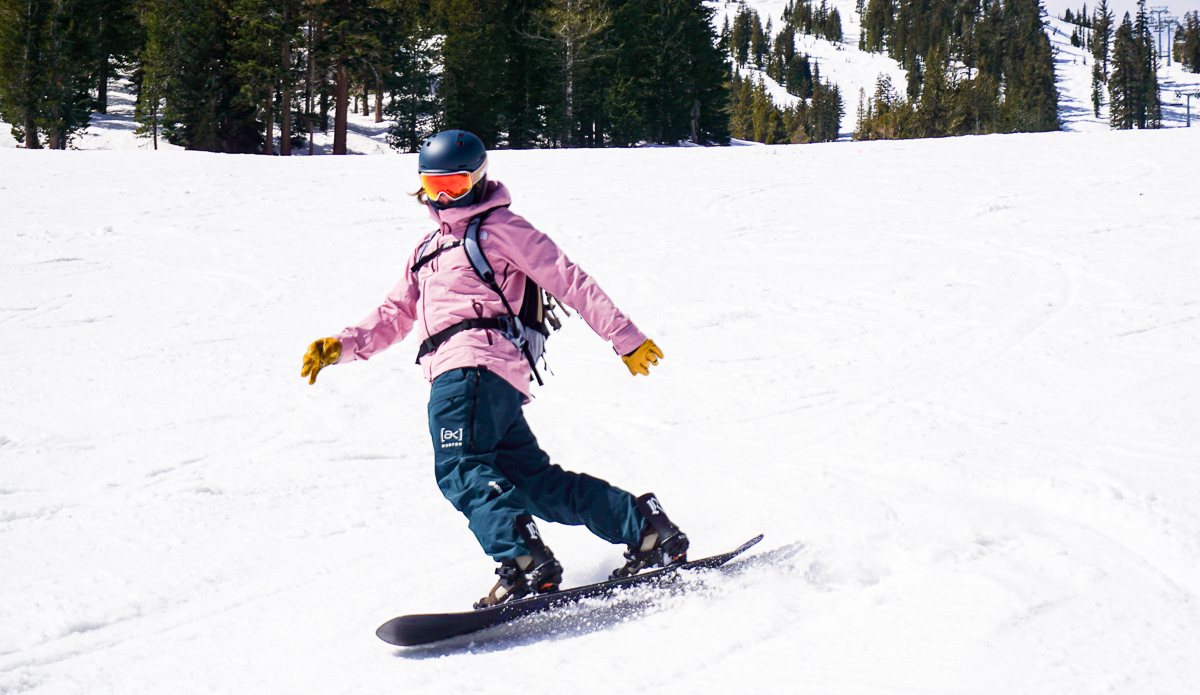
Good snowboard pants keep you warm, dry, and allow you to move. Photo: Will Sileo//The Inertia
Snowboard pants have come a long way in recent decades. With modern waterproofing, breathable membranes, and repellent treatments, it is easier than ever to stay warm and dry on the mountain. We’ve been testing the best snowboard pants on the market from major brands and newcomers alike to build a comprehensive list of options for every rider. From insulated pants to high-output backcountry bibs, we’ve put dozens of snowboard pants to the test. Over the past three seasons, we’ve dialed in this guide, and we continue to test and improve it throughout the winter. Read on for our top picks!
Navigate To: Comparison Table | How We Tested | Buyer’s Guide
Related: Best Women’s Snowboard Pants | Best Snowboard Jackets | More Snowboard Gear
Editor’s Note: We improved this guide in November 2025 with refreshed links, additional product information, and updated navigation. The Burton [ak] Cyclic remains our favorite option this year! We’ve already started early-season testing new snowboard pants for our next update, so stay tuned for new picks!
The Best Snowboard Pants of 2025/2026
Best Overall Snowboard Pants: Burton [ak] Cyclic Bib
Best Budget Snowboard Pants: Quiksilver Mission
Best Backcountry Snowboard Bibs: Burton [ak] Freebird Bibs
Best Insulated Snowboard Pants: Patagonia Insulated Storm Shift
Best Overall Snowboard Pants
Burton [ak] Cyclic Bib ($510)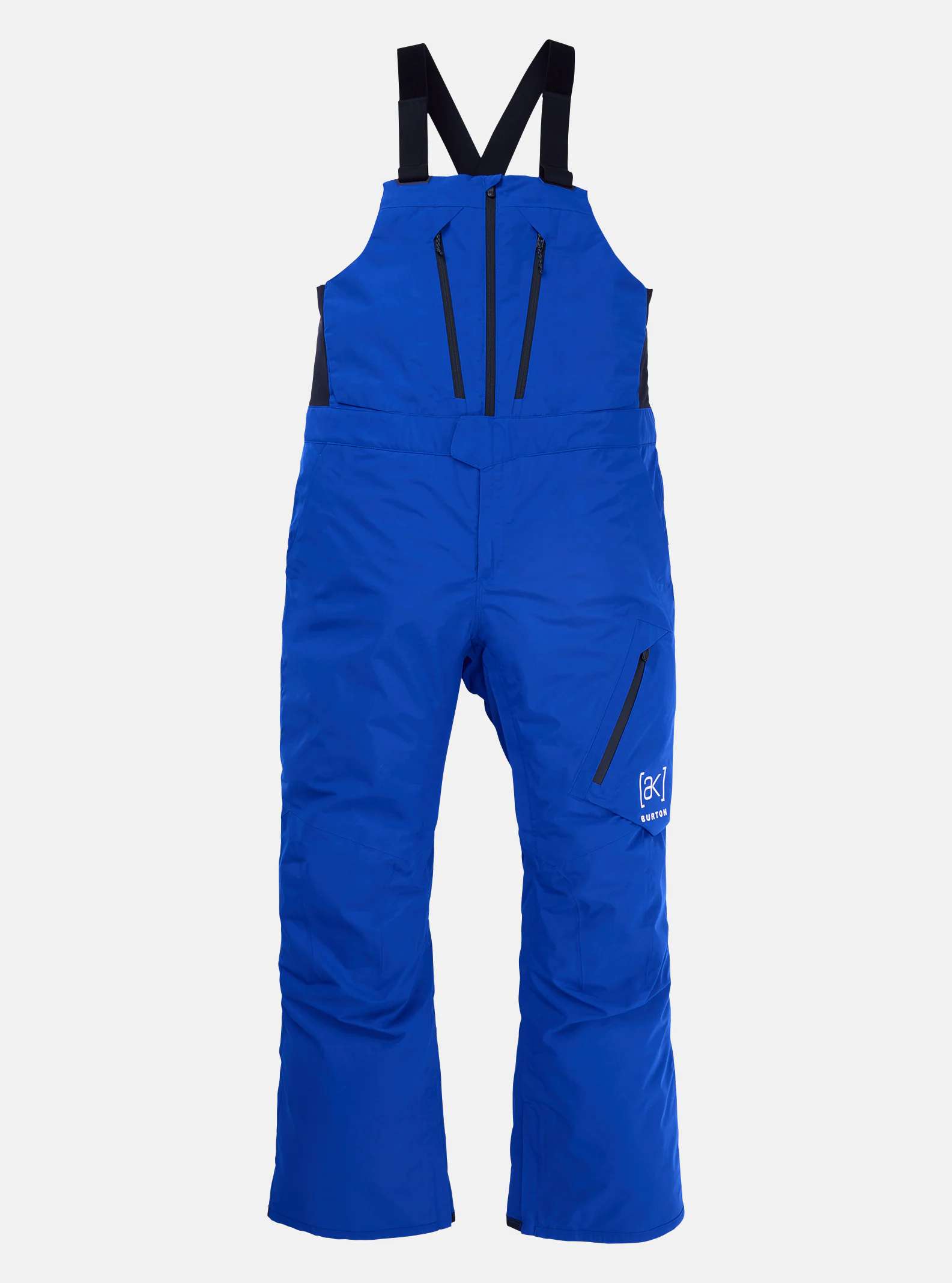
Waterproofing: 2L GORE-TEX
Insulation: None
Features: Big pockets
Pros: Lightweight, waterproof, fairly breathable
Cons: 2L construction, no insulation
Burton’s [ak] line is over 20 years in the making, and each year, their talented team of riders and designers refines the product a bit more. The result is a pair of snowboard bib pants that look great, feel great, and hit all the right notes to make this our favorite pair of snowboard pants.
As for the right combination of durability and lightweight, the Burton [ak] Cyclic Bib is pretty ideal, with GORE-TEX protection and an articulated fit that’s made to move with you. It’s also easy to see that a lot of thought went into features, like pocket placement. The bibs sport two large zippered chest pockets, which are great because you can have wet (think backcountry skins) and dry storage within easy reach that stays safe under your jacket. Mesh-lined, inner-thigh vents let you dump heat as needed.
These snowboard pants are made to last, but if they don’t, you also have Burton’s limited lifetime warranty, so they will fix or replace anything that is out of whack. On the sustainability side, Burton has transitioned to all gear getting the Bluesign seal of approval. It’s good to see snowboarding’s top brand taking environmental responsibility seriously.
Check Price on BackcountryBest Budget Snowboard Pants
Quiksilver Mission ($270)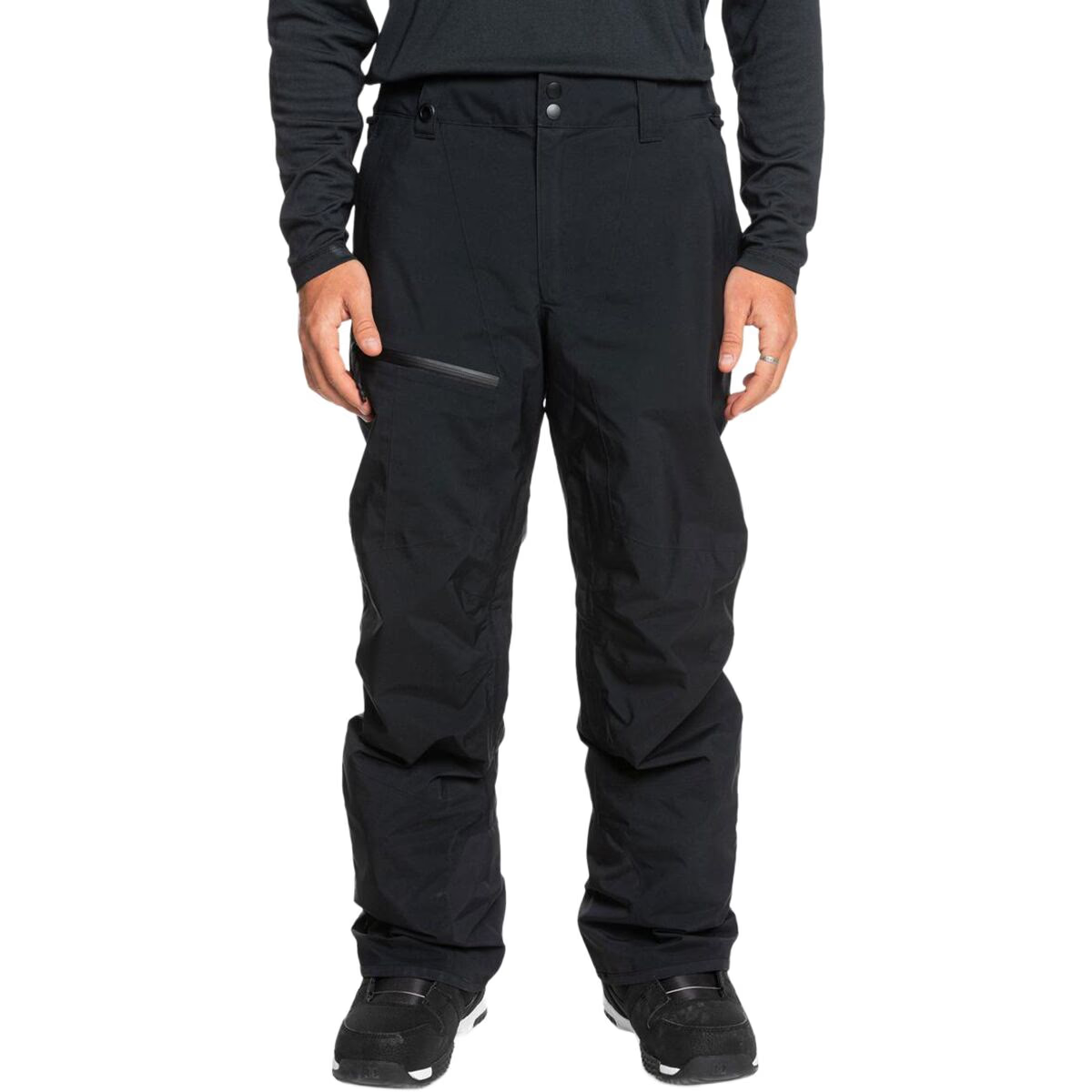
Waterproofing: GORE-TEX
Insulation: None, but liner provides slight warmth
Features: Inward-facing vents
Pros: Lightweight with GORE-TEX protection
Cons: Not as durable as other GORE-TEX pants
Pants are definitely one of the categories in snowboarding gear where less is sometimes more. One may not need all the bells and whistles as long as the pants offer protection from the elements, and do not get in the way when popping big airs or poking out a good method.
The Quiksilver Mission pants do just that, offering GORE-TEX protection in a very lightweight and unobtrusive package. They are easy to ride and offer great freedom of movement, giving people what they need to have a good time out there. What they lack is a hefty price tag, clocking in at even less than the cost of some day tickets at bigger resorts, believe it or not. The pants are by no means bare bones, with well-placed pockets, internal gaiters, and a lining that gives you one extra layer so as not to need anything too bulky underneath to keep warm. For the price, you’ll be hard-pressed to find something that performs as well as the Quiksilver Mission pants.
Check Price on BackcountryBest Backcountry Snowboard Pants
Burton [ak] Freebird Bibs ($699)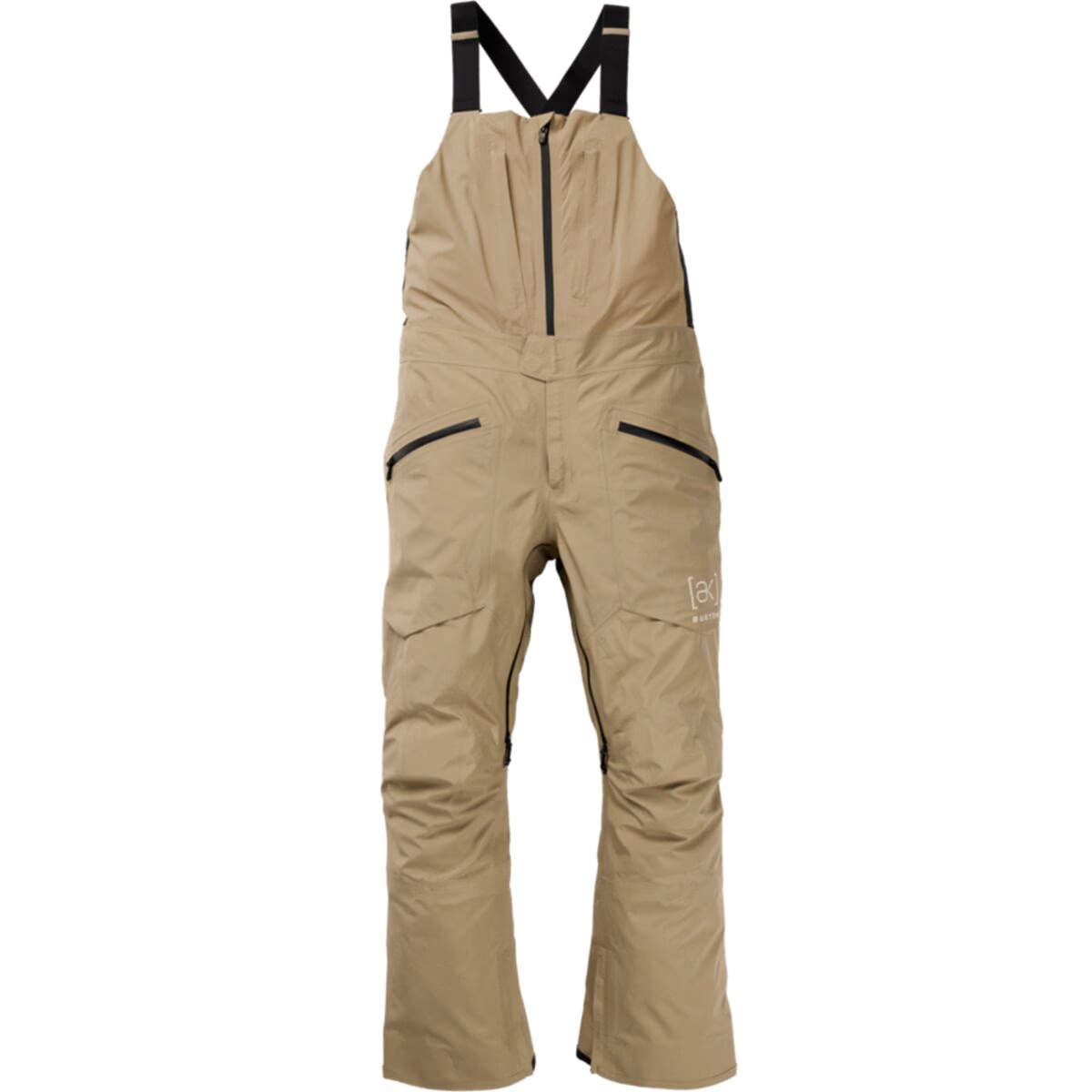
Waterproofing: 3L GORE-TEX
Features: GORE-TEX C-Knit fabric, vest-style bibs
Pros: Lightweight, comfortable, excellent weather protection
Cons: Pricey
It doesn’t get much better than the Burton [ak] Freebird Bibs, and if they weren’t so pricey, we might recommend them as the best all-around snowboard bibs out there. Regardless, a backcountry kit requires specialized equipment, and the Freebird stunned us with performance, comfort, and protection. Pockets and ventilation abound in these bibs, and while moisture protection is among the best in test, the breathability and mobility on the Freebird are truly impressive. The GTX C-Knit is softer to the touch and feels a bit more flexible than the standard kit, which is great for hiking uphill routes.
In many ways, the Burton [ak] Freebird Bibs feel like our top pick, the Cyclic. Fit, cut, and pockets feel pretty familiar, but the upgraded fabric is what makes the Freebird stand out in the backcountry. Increased breathability, flexibility, and packability due to the 3L shell (vs 2L in the Cyclic) differentiated these. And believe us, it works. Moisture did not creep in, whether we were riding in wet slush or heavy falling snow. Yet, the excellent ventilation system allowed us to dump heat quickly, and the comfortable fabric breathed notably well when moving. Memorable testing included an absolute dump of wet western pow in Arizona Snowbowl, where hiking beyond the lifts led to excellent powder stashes—the Freebird was built for conditions like these.
Check Price on Backcountry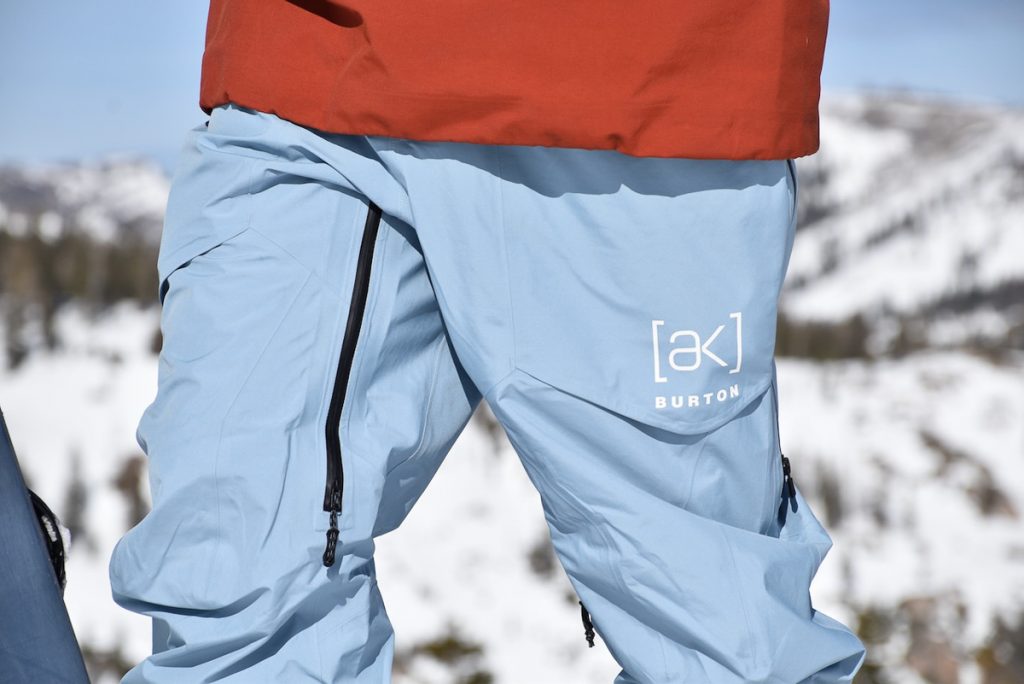
The Burton [ak] Freebird Bibs were some of the best we’ve ever tested, but they are pricey. Photo: Nick Bruckbauer//The Inertia
Best Insulated Snowboard Pants
Patagonia Insulated Storm Shift ($449)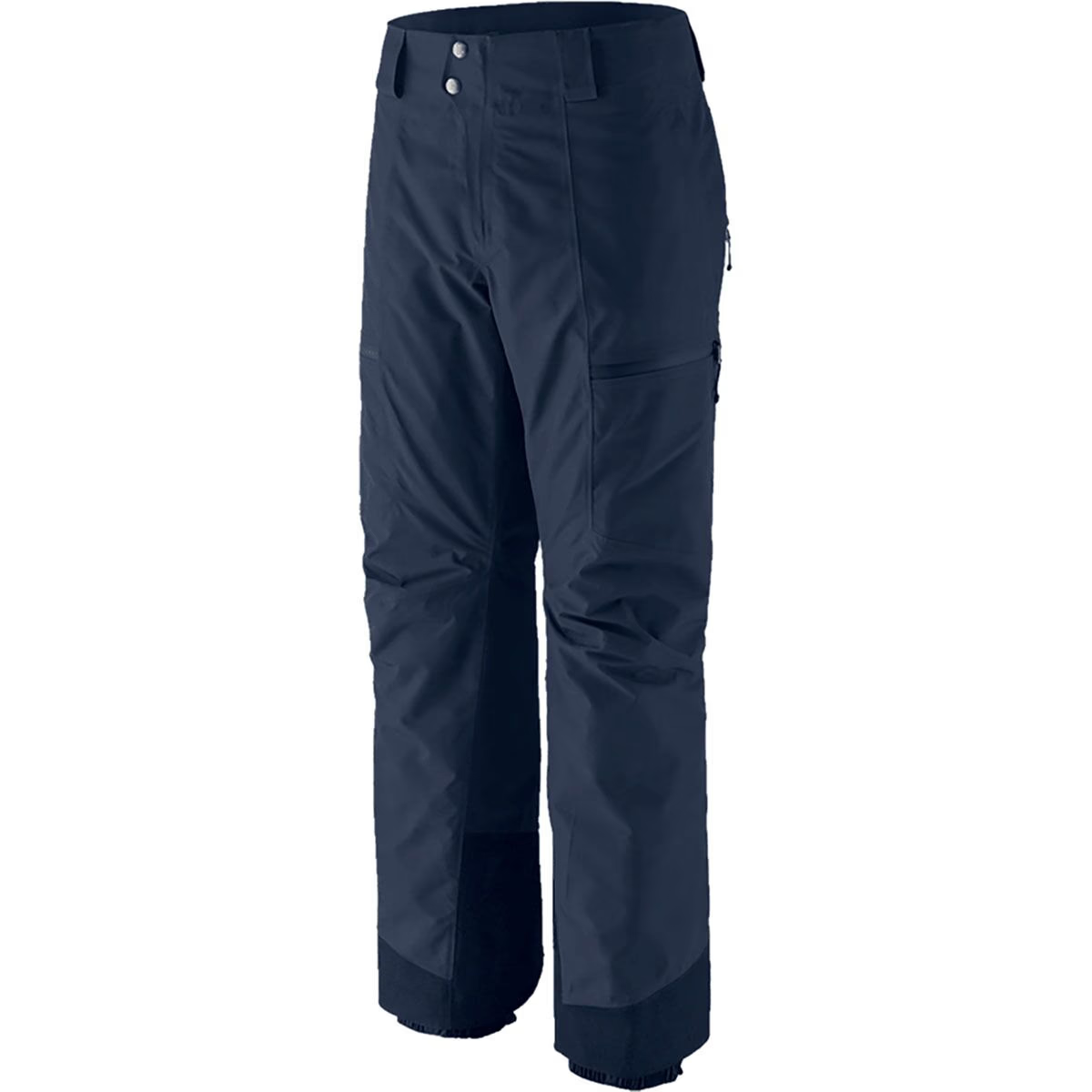
Waterproofing: 2L GORE-TEX
Insulation: 60g Thermogreen
Features: Lined pockets
Pros: Great protection from the elements
Cons: Pockets are small
The Patagonia Insulated Storm Shift seriously impressed our team with true all-around cold-weather performance. The pants look great (even for snowboarders, who tend toward a baggier style), have impressive durability, excellent waterproofing (2L GTX), and warm Thermogreen insulation, but still have plenty of ventilation for dumping heat on warmer days. An awesome resort riding option, the Insulated Storm Shift will keep you comfortable even on a chilly lift, and readily move with you as you lay trenches.
The 2L GORE-TEX and reinforced gaiters kept all types of snow and sludge out, even though we made an effort to step in some slush puddles. Two handwarmer pockets are well-lined to keep digits warm if gloves get soaked and you need some relief, while thigh pockets provide extra storage. Two mesh-lined vents let you ventilate while still keeping snow out.
Of course, it wouldn’t be a Patagonia review without mentioning their efforts to help improve the planet, so it’s good to know they don’t use fluorinated chemicals in the waterproofing layer, which is good for both humans and the ecosystems we play in. The company’s goal to keep their garments in circulation via repairs over replacement means even if you give these snowboard pants some love, Patagonia has your back (and bottom) to keep these snowboard pants going season after season.
We also tested the uninsulated version of the Storm Shift, and absolutely loved it. These pants were a former top pick for all-day wear, and remain a regular in our rotation.
Read our full review of the non-insulated Patagonia Storm Shift Pants.
Check Price on Backcountry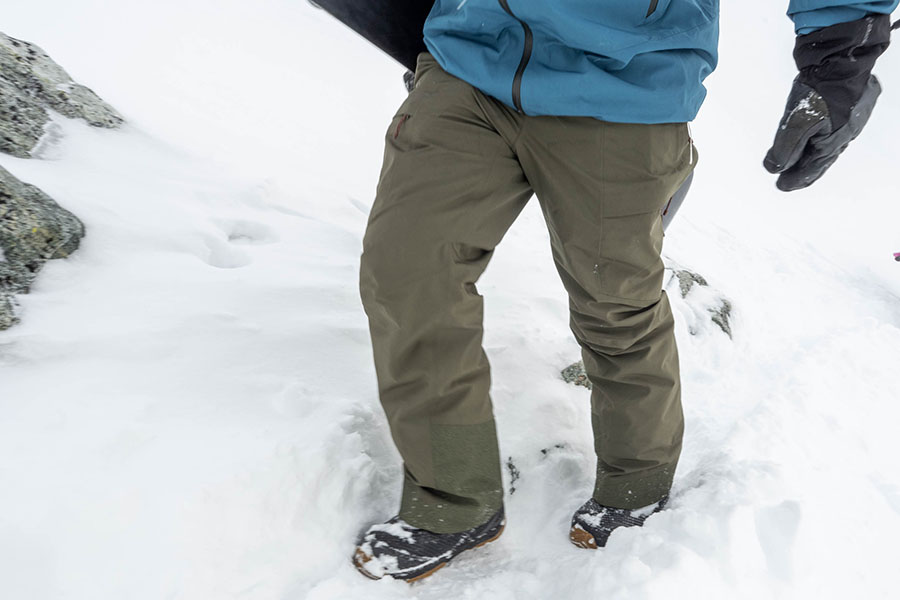
Durable and warm, the Patagonia Storm Shift won us over. Photo: Steve Andrews//The Inertia
More Snowboard Pants We Recommend
Runner-Up Best Backcountry Snowboard Bibs
Jones Shralpinist Stretch Recycled Bibs ($475)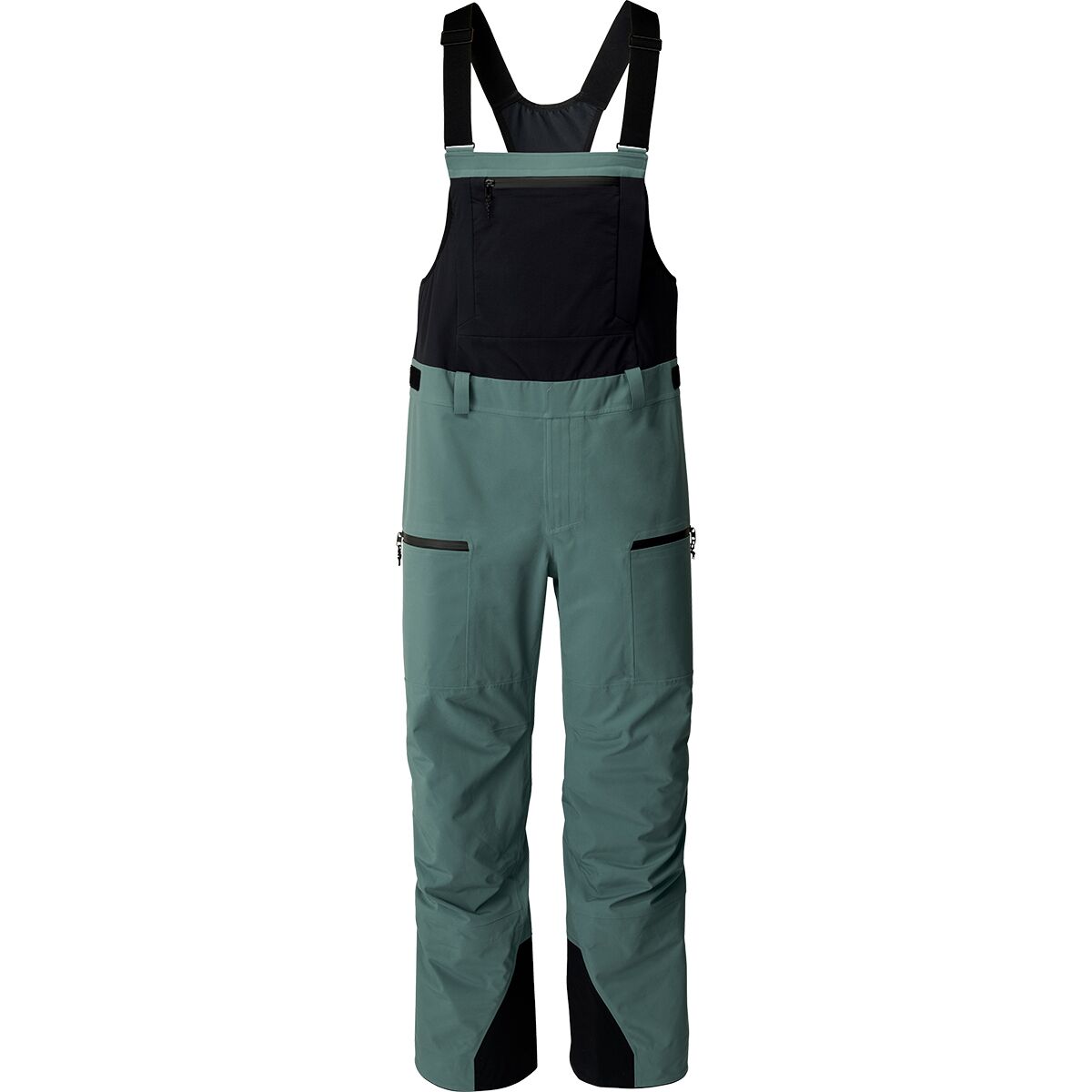
Waterproofing: 3L 30K/30K
Insulation: None
Features: Excellent mobility, improved durability
Pros: Excellent mobility and breathability
Cons: Not quite as waterproof feeling as Freebird
Whew, we loved the Jones Shralpinist Stretch Bibs this year (and the whole kit). Despite a few quirks that ultimately had the Freebird beat it out, the Shralpinist Stretch kit is an extremely comfortable and practical pair of bibs for the backcountry. Breathability is paramount here, and for super wet conditions, we might recommend you opt for the Shralpinist kit with GTX (this one uses a proprietary Jones waterproof fabric). We do most of our backcountry riding in the west and southwest, where this kit really shines. Ventilation on warmer days is no problem, and the pocket arrangement is solid (though not quite as good as the Freebird).
Fit was pretty good—we were between sizes and opted to go up for better layering, which caused a bit of droop in the front of the bibs. If you’re on the edge, opt for the smaller size for a truly well-fitting bib (unless you like the baggy style, which isn’t always practical in the backcountry). Otherwise, we loved this kit—it’s not the best choice for sitting on cold lifts or snow (it’s so breathable), but for spring laps, huge backcountry climbs, and hardworking riders, this bib is not to be trifled with. Also, they are a lot less expensive than the Freebird, just food for thought.
Check Price on Backcountry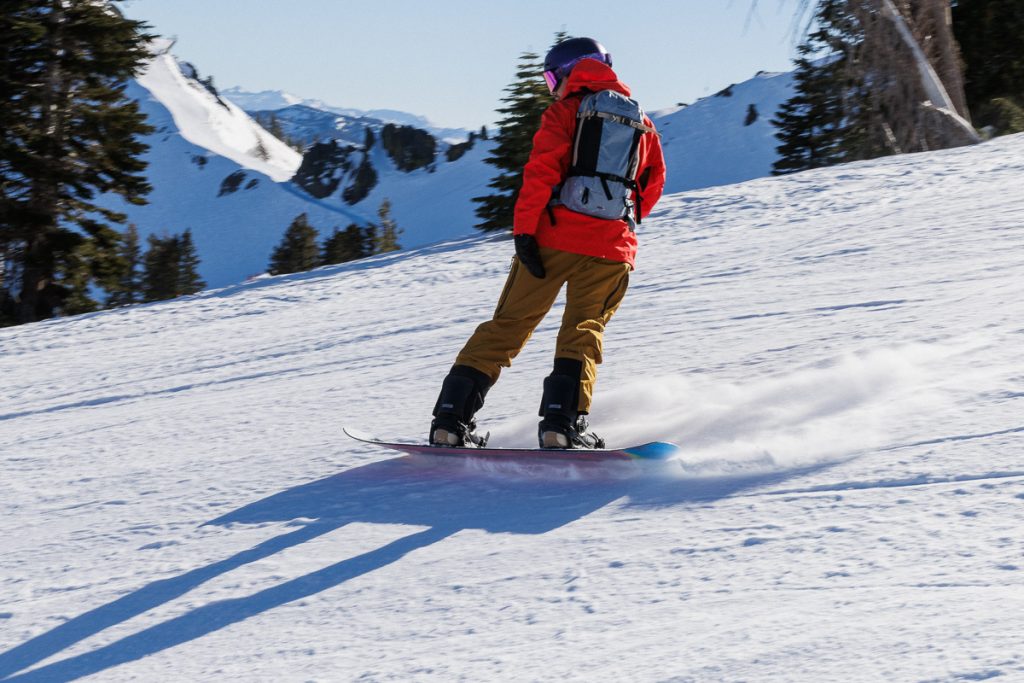
Stretchy and mobile, the Jones Shralpinist Stretch are some of our favorites for hoofing it uphill. Photo: Tim Manning//The Inertia
Extreme Durability
Arc’teryx Sabre Bib ($700)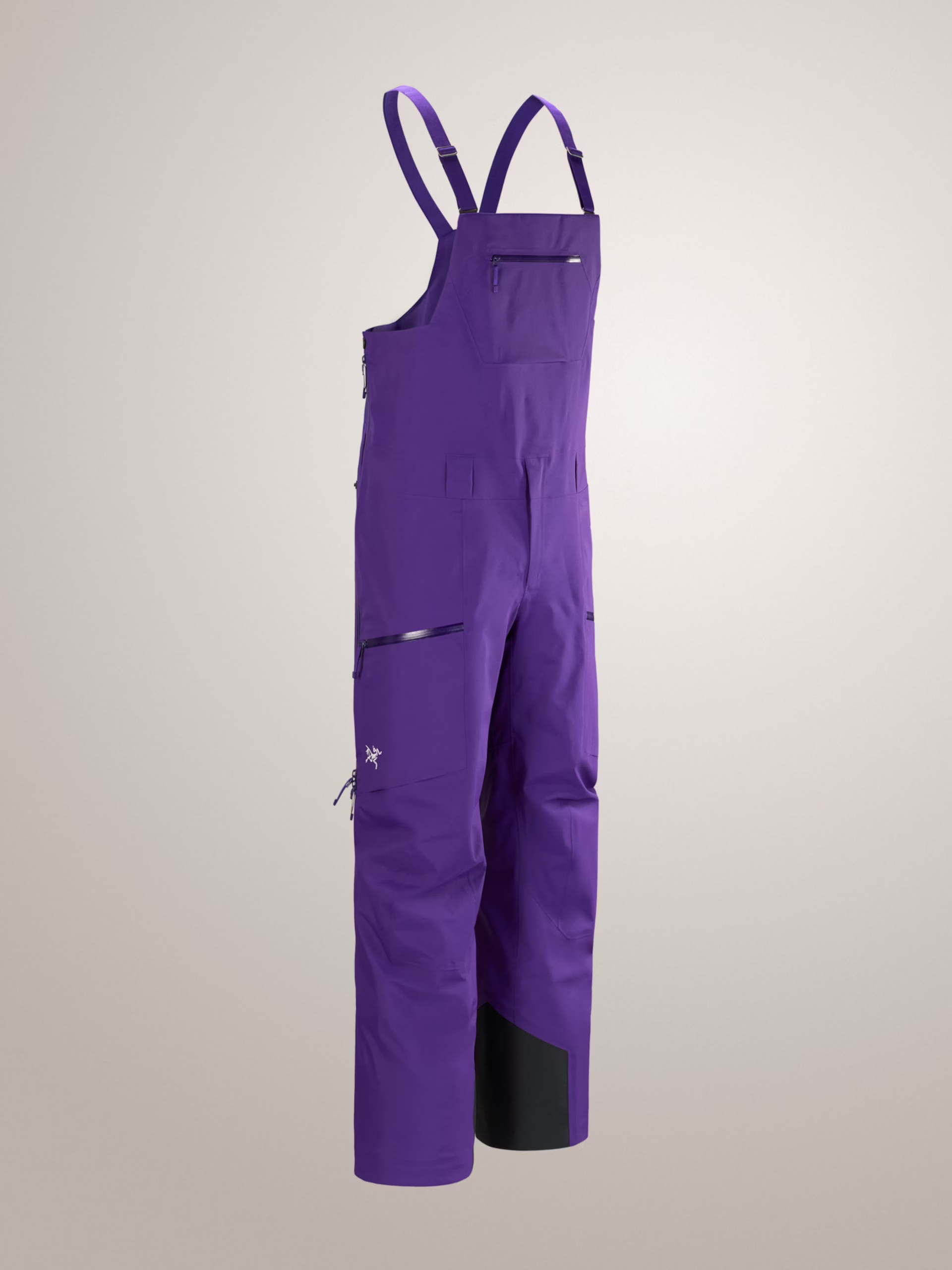
Waterproofing: 3L GORE-TEX
Insulation: None
Features: Rubber-sealed zippers
Pros: Can take a beating
Cons: Fairly rigid and unforgiving
The Arc’teryx Sabre Bib has the primo construction that the brand has become known for. With 3L GORE-TEX, the only way you’ll get damp is if you forget to close the massive vents on the sides, something that’s not too hard to do! Be careful, though; unlike some other pant vents, there is no interior mesh keeping you from unzipping too far and letting in unwelcome slush. But as far as the material with which it’s made – that’s where these snowboard bibs shine.
The seams are well hidden, perhaps the best of what we tested, and you can tell that there was no skimping when it came to quality construction. Zippers also include a rubberized seal to help keep pockets from leaking. Not much bad can be said for these bibs. The material doesn’t move quite as well as some other options on this list, but that’s a fair trade-off for the bomber construction. Also worth noting is that Arc’teryx has updated its warranty to be a “limited” lifetime warranty, so if you’re the person who rides hard and wears the gear out fast, there might be some pushback on their end on how far they will go to service the gear. But as a quality piece of gear that hangs well and will withstand the elements, the Sabre is a great option.
If you’re not into bibs, check out the Arc’teryx Sabre Pants.
Check Price on Arc'teryxRunner-Up Best Snowboard Pants
Burton [ak] Swash ($480)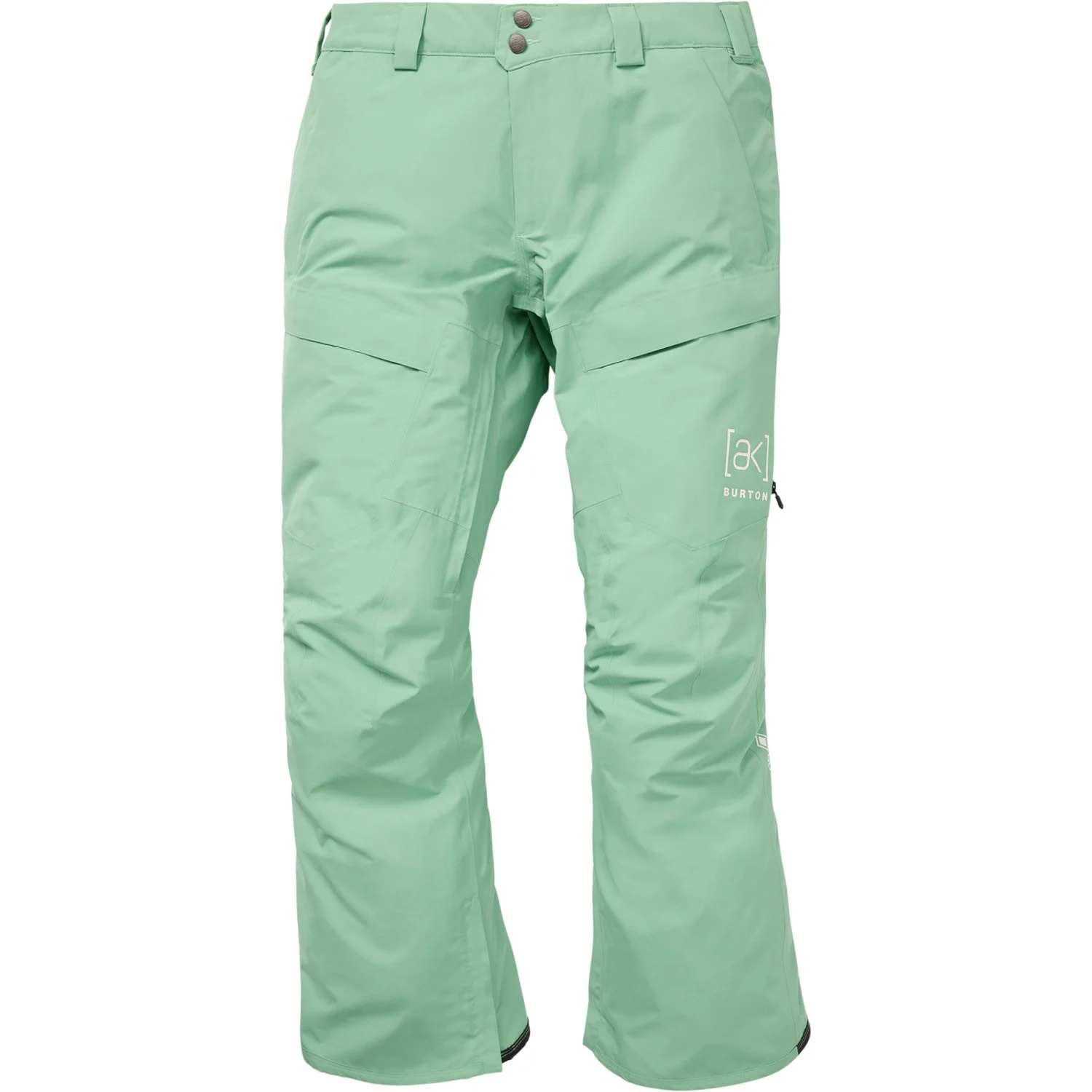
Waterproofing: 2L GORE-TEX
Insulation: Living Lining mapped mesh
Features: Durable, tons of pockets
Pros: Excellent pockets, full-featured
Cons: 2L material is somewhat stiff
The Burton [ak] Swash almost unseated our top-pick Cyclic, above, but we still think bibs offer slightly more practicality than pants. That said, if you are a snowboard pants over bibs type, then you cannot go wrong with the Swash. With one of the better pocket layouts and venting systems we’ve found in resort pants, the Swash is our go-to for most days on the mountain. Sure, the 2L GTX isn’t quite as breathable or flexible as a dedicated backcountry kit, but we found it to be very protective in the elements, whether it be a chilly lift seat or wet snow. The material is super tough, and we snagged this on a couple of trees on a hectic run on Mammoth Mountain that left the pants no worse for wear. While a bit pricey, the Swash is often on sale at the end of the season for a great deal, and these pants will last you seasons.
Check Price on EVO Check Price on Backcountry
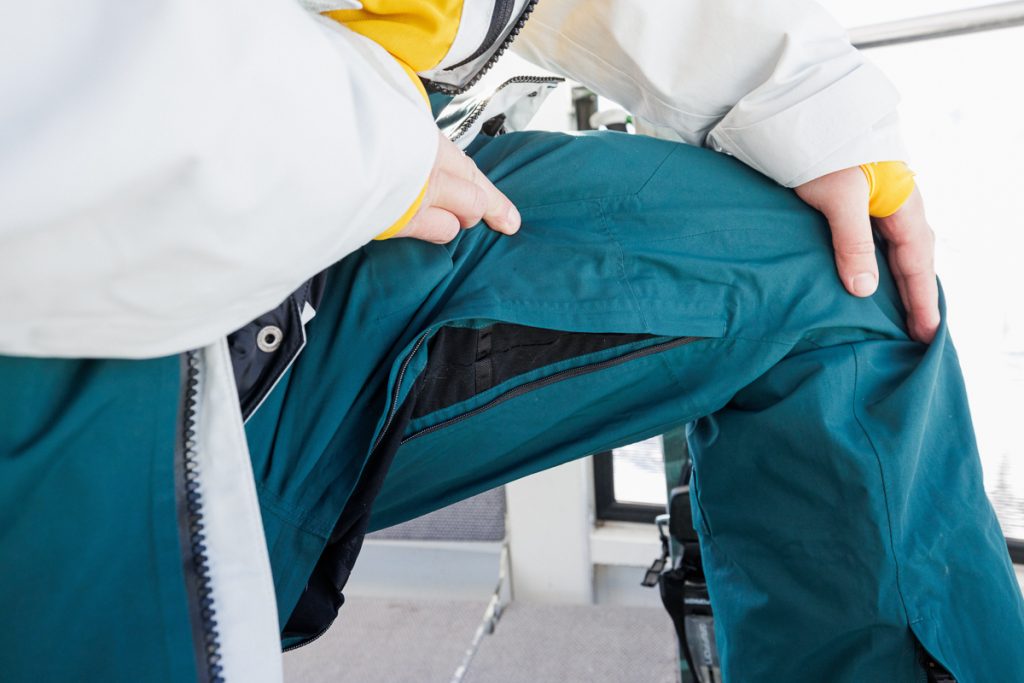
The awesome mesh vents in the crotch of the Burton [ak] Swash are great for dumping heat. Photo: Tim Manning//The Inertia
Runner-Up Best Budget Snowboard Pants
REI Co-op First Chair GTX Bibs ($269)
Waterproofing: 2L GORE-TEX
Insulation: None
Features: Lined pockets
Pros: Great protection from the elements
Cons: Pockets are small
Prefer bibs to pants? The REI Co-op First Chair GTX Bibs pack impressive material into a very affordable pair of snowboarding pants. Style may trend toward skiers, but for just over $250 (and often on sale), it’s hard to find bona fide 2L Gore-Tex fabric in any pants. The pockets are somewhat limited, but they provide enough storage for resort laps, and the fit is great—not too loose, not too tight. Durability has been superb, and we’ve found that the 2L GTX ePE fabric has held up just as well as any other brand, despite being much cheaper. For someone just getting into the sport, this is an awesome option.
Check Price on REI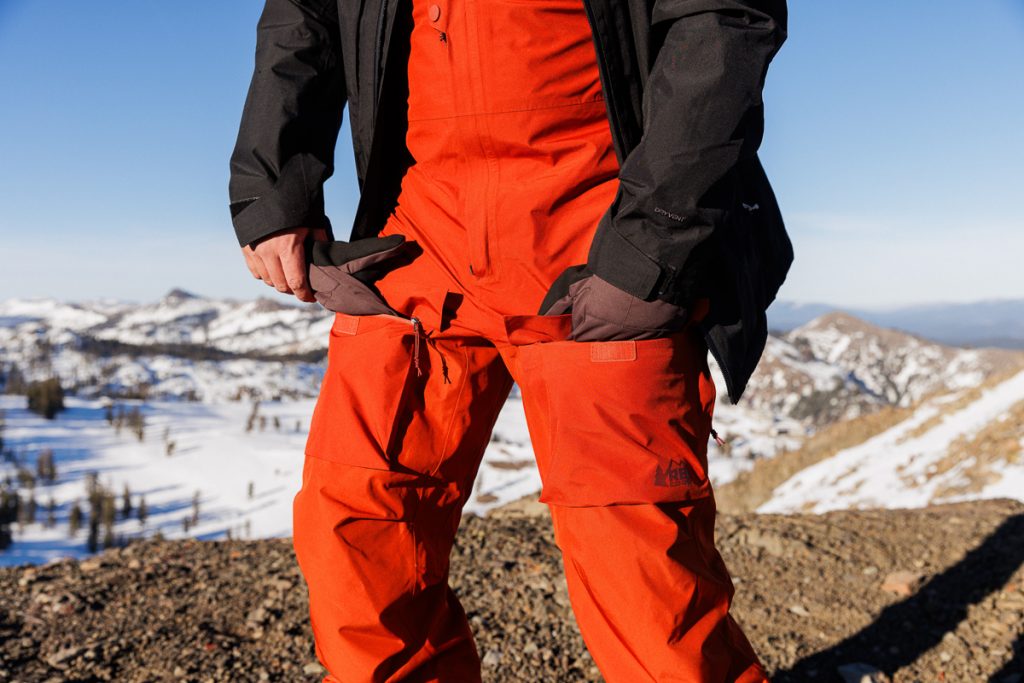
Reliable and inexpensive, the REI Co-op First Chair GTX Bibs are a solid value. Photo: Tim Manning//The Inertia
Runner-Up Best Insulated Snowboard Pants
Mountain Hardwear Cloud Bank ($400)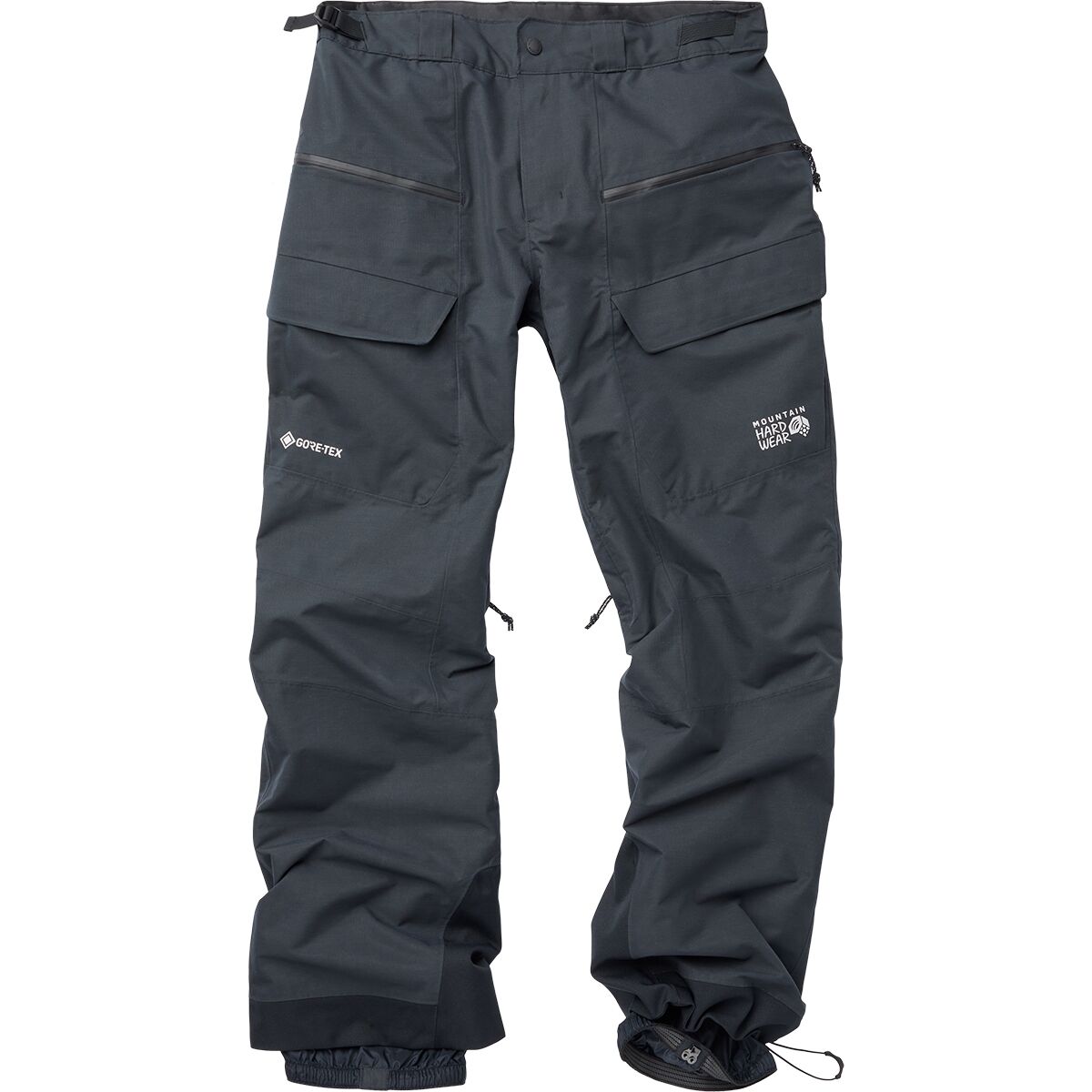
Waterproofing: 2L GORE-TEX
Insulation: 60g Synthetic (85% recycled)
Features: Ideal insulation and good fit
Pros: Insulated, comfortable liner
Cons: Insulation isn’t removable
For those who don’t like layering up too much underneath, or if you’re just in a really cold place and could use all the warmth you could get, then we were big fans of the Cloud Bank by Mountain Hardwear. Made with a GORE-TEX membrane, 100% recycled polyester on the exterior, and 60g synthetic insulation inside, it’s going to keep you warm and dry better than a lot of what’s available out there.
The lining had a super smooth, comfortable feel that felt more premium than the price of these pants suggests. We would have awarded it “Best Value,” but it didn’t quite match the price point we look for in that award, so we simply recommend it here if you like insulated pants. Despite the insulation, they aren’t overly bulky and give you plenty of movement for a big day out, while also giving enough warmth if you are stuck in line or have to wait out on the chairlift. Sadly, that’s more of a reality these days than any of us like to admit, so for the pragmatic folks, you might appreciate the extra insulation here and get the pants before you have to experience the cold firsthand.
Check Price on BackcountryExcellent Pockets
Mountain Hardwear Boundary Ridge Bib ($500)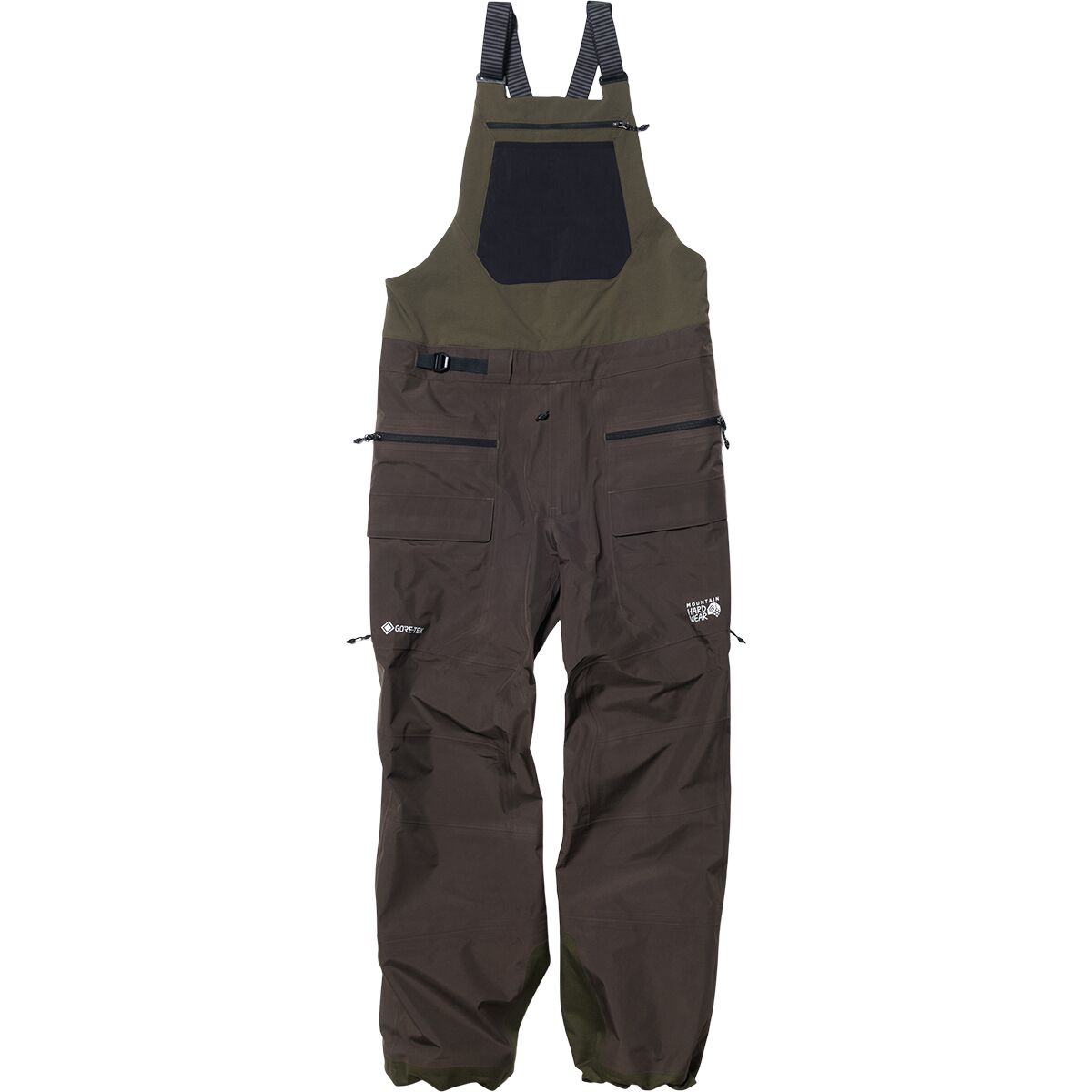
Waterproofing: 3L GORE-TEX
Insulation: None
Features: Good pocket layout
Pros: Extremely durable, great pockets
Cons: Mesh chest pocket does not zip
Mountain Hardwear makes a great product. They haven’t always been at the forefront of the snowboarding scene, but their quality construction earned them a couple of spots on the list.
The 3L GORE-TEX material is, without a doubt, the best bang for your buck that you’ll get for snowboard pants that won’t soak through. Because these are bibs, a good portion of the torso is well-protected as well, and attaching this to the Boundary Ridge Jacket kept us warm and dry throughout anything we, or the mountain, threw at it.
With zip and cargo pockets on the sides, as well as both a zip and mesh pocket on the chest, there is plenty of space to stash what you need. Just be careful with valuables in the mesh chest pocket because it has the potential to fall out if you tumble. The side vents are large enough to do a quick flush on the go and zip back in seconds, earning major breathability points, especially for a 3L GORE-TEX build.
Check Price on BackcountrySuper Stretch
Dakine Sender Stretch Pants ($475)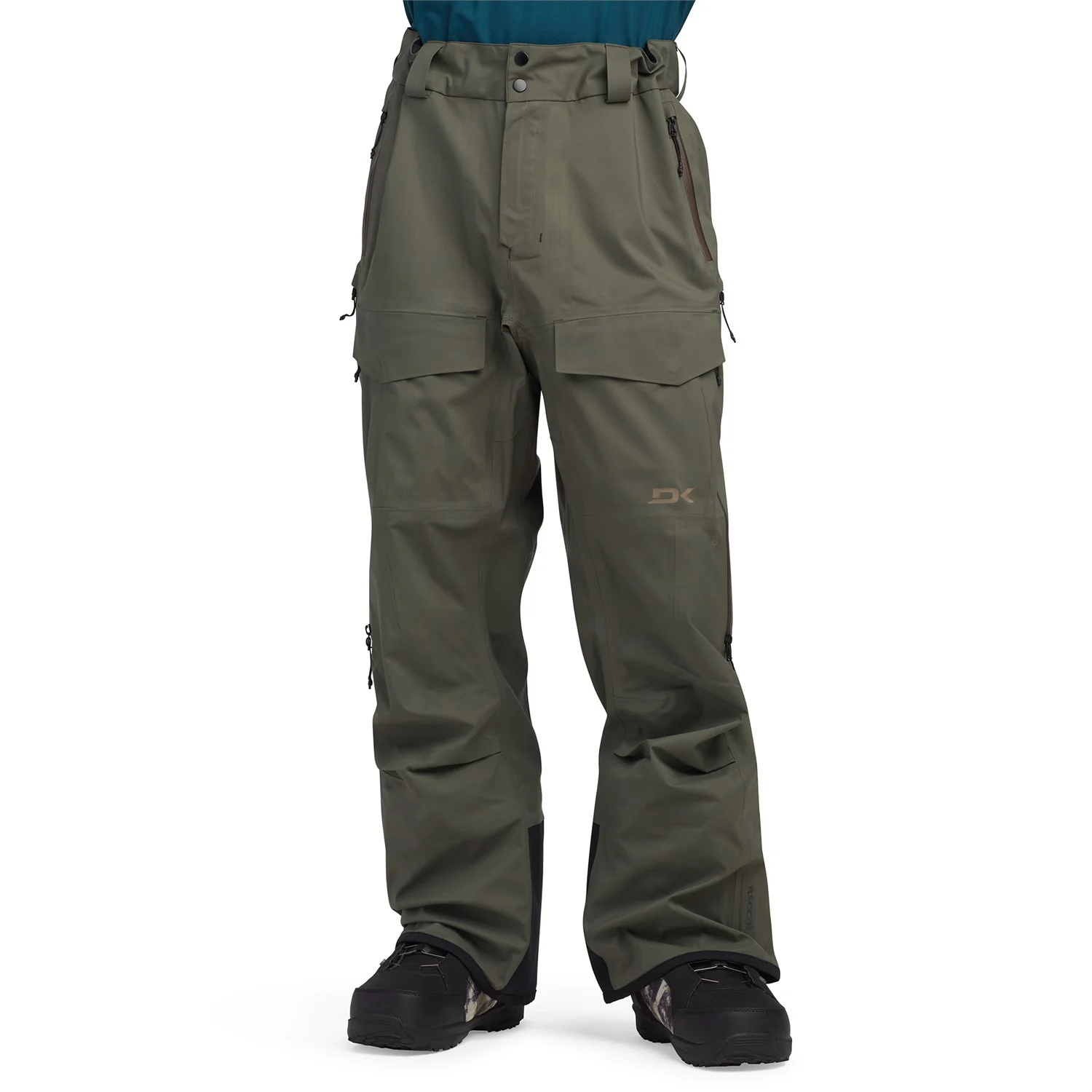
Waterproofing: 3L 20K/20K
Insulation: None
Features: Super stretchy
Pros: Nice flex allows you to send it without being held back
Cons: Not GORE-TEX, runs large
Dakine’s Sender Stretch Pants are exactly what the name implies. A roomy, if not baggy fit and stretchy material makes for unrestricted movement on the sendiest of jumps and maneuvers, and is also exceedingly comfortable. Featuring 20k waterproofing and 20k breathability, these snowboard pants are as waterproof as they are breathable, with a PFC-free DWR and 3L construction made of recycled materials. If you need more breathability, exterior thigh vents let you dump heat with ease.
A fairly hidden but highly important feature these snowboard pants sport is the adjustable waistband with a drawstring that lets you cinch the pants down snugly without needing a belt.
The biggest downside is the pockets, as the pants only feature the two front cargo pockets you can see in the photo above, as well as two back pockets. If you’re riding the lifts, those two back pockets won’t do you much good besides giving you somewhere to stash your pass, leaving you with just the front two pockets for everything else. That said, the pockets are roomy and well-made, with magnetic flap closures for ease of use, as well as zippers should you need the added security. And paired with the right jacket or a backpack, the lack of pockets shouldn’t be an issue.
These snowboard pants also took a hit on warranty, with Dakine only offering a 2-year guarantee on manufacturing defects. Any self-inflicted rips will be yours to take care of.
Check Price on EvoTREW Gear Tatoosh ($349)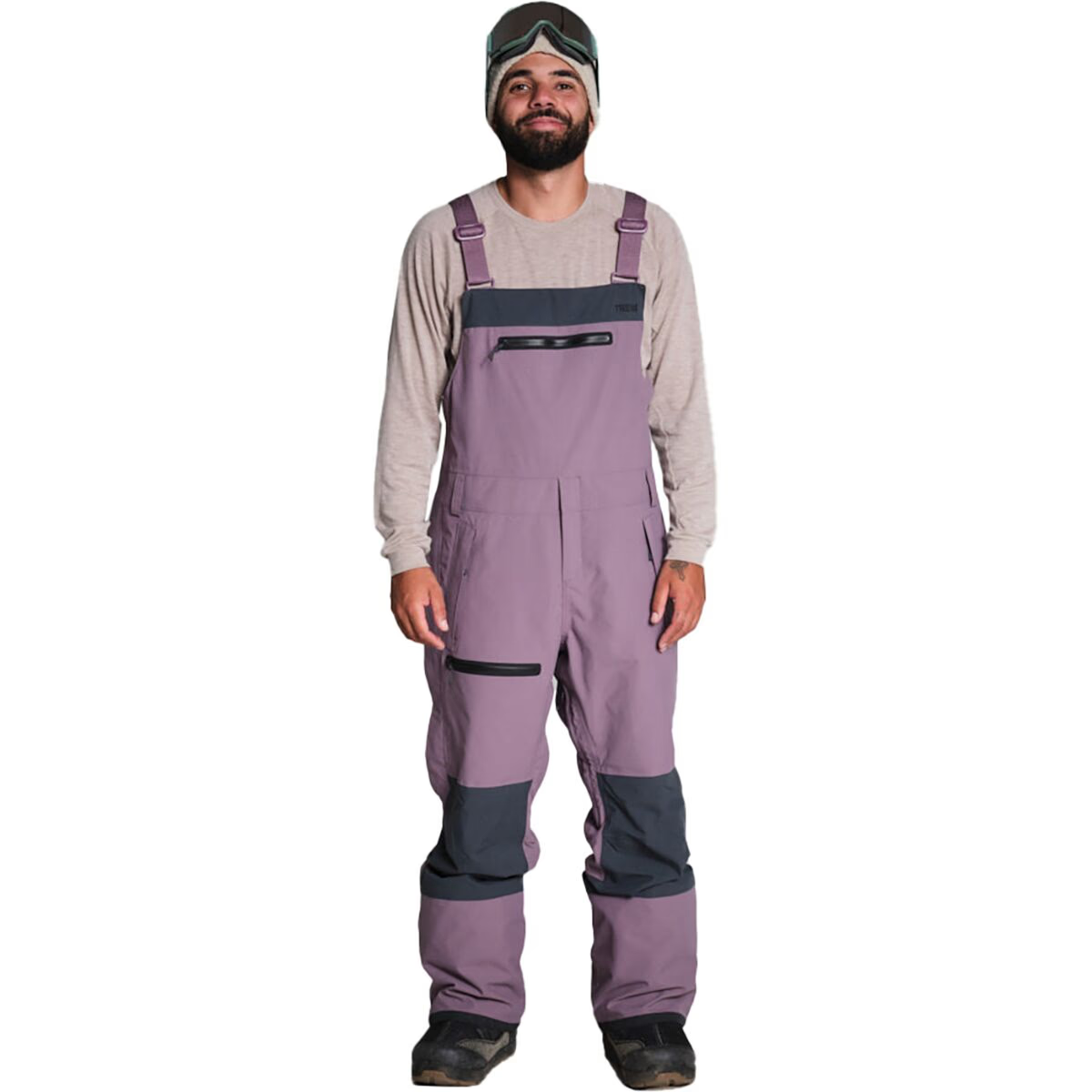
Waterproofing: PNW 2L
Insulation: Hi-Loft 60g Insulation
Features: Great colors and just enough insulation
Pros: Warm, durable, and comfortable
Cons: Bulky
Named after the wild range adjacent to Mount Rainier, a cornerstone of the PNW Landscape, the Trew Gear Tatoosh Bibs would do well within their namesake. Sporting 60g insulation, these bibs will give the extra layer necessary to stay out longer when the mercury drops down low. Despite the warmth, we felt they were roomy and breathable enough not to collect sweat, but with that, you do have a bit of extra added weight.
The big bonus to these pants is the comfort. It’s no secret that GORE-TEX fabric can generally be quite rigid, but the nylon weave for these pants makes it feel much easier to wear. At 20K, it’s not as bomb-proof as GORE’s 28K rating, but it’s a question of whether or not you want to trade the comfort for days when it’s just getting soaked. Many people would rather do other things during a rainstorm, so if that’s you, the comfort points might win out.
Read our full review of the Tatoosh Bibs.
Check Price on BackcountrySustainable and Backcountry-Ready
Patagonia Snowdrifter ($399)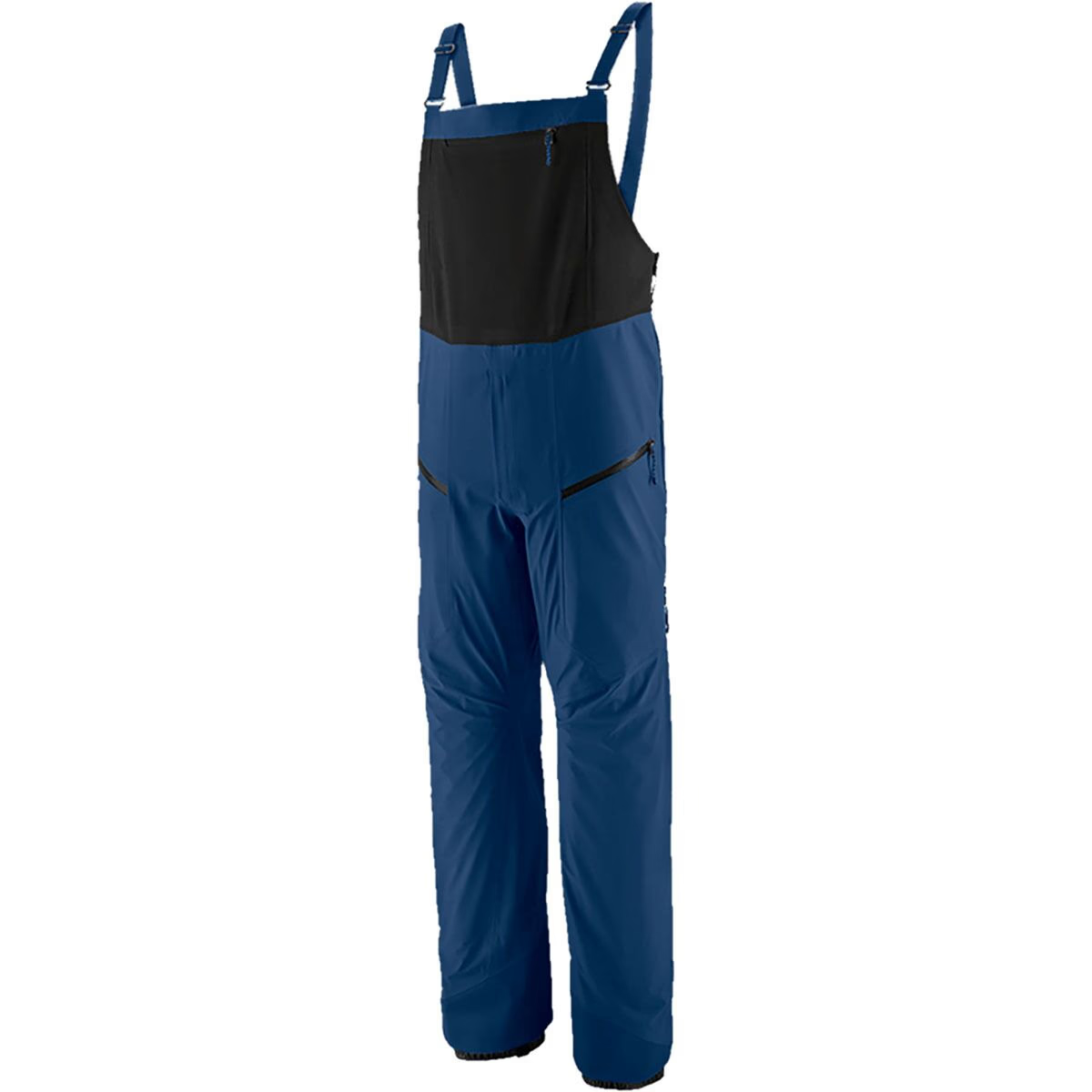
Waterproofing: 3L H2No
Insulation: None
Features: Stretchy
Pros: Stretchy and lightweight
Cons: Shoulder straps can come loose
If you need a lightweight bib for backcountry missions that can also withstand the elements, we loved the Snowdrifter. They have enough stretch to give you the freedom to move and feel like there is barely anything on while riding, while still providing storm-ready, 3L protection. That’s reason enough to recommend, but the added bonus (which may be the primary reason for many) is that the material is 100% recycled. On top of that, the DWR coating is free of the harmful PFC chemicals that are traditionally used for waterproof coatings. Add in the fact that the people making the gear were paid a fair wage under the Fair Trade standard, and this is a pair of snowboard pants that you can feel good about wearing.
We did notice, though, that in heavy use the shoulder straps would come a little loose. A simple tape job can fix that, but then you must sacrifice the quick-release, which is a welcome feature for many, especially when nature calls. Another feature that caused a bit of frustration was that the zipper on the thigh pockets would get stuck on occasion. It was never a permanent stick, but it happened more than once, so it’s worth noting. That’s not exactly a dealbreaker considering that the pros far outweigh the cons. We found that using the zipper with two hands solved this issue fairly easily.
Check Price on BackcountryRugged and Versatile
Volcom Guide Pants ($640)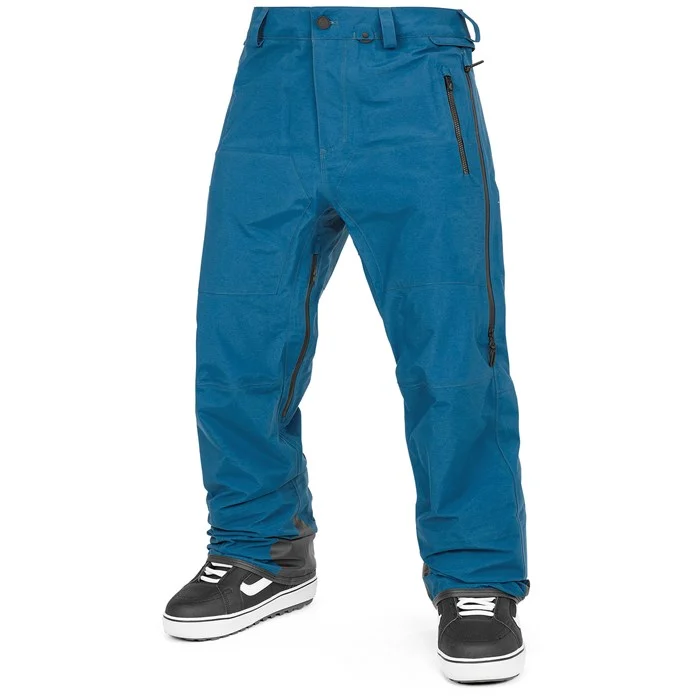
Waterproofing: 3L GORE-TEX
Insulation: None
Features: Reinforced butt patch
Pros: Built to last, reinforced at all the right spots
Cons: Pricey for a shell
Designed for, and developed alongside the guide staff at the legendary Baldface Lodge, Volcom’s Guide Pants were built and tested for all-day wear, day in and day out. Guiding is a unique profession in that it’s often glamorized as being super awesome, but it takes more than a good snowboarder or skier to succeed. It takes a cool head, quick thinking, and a lack of ego to help a group of 12 make it down from the top to the bottom of a deep powder run in one piece. Often getting up before daybreak to do weather observations and shutting down the bar with clients at night, the guide needs gear that provides comfort, protection, and reliability.
The Guide pants give you all these, with added style points in their simple yet well-hanging design. The unsung hero of these pants is the rugged zippers that are easy to open and close in a hurry and won’t bog you down fumbling around in gloves. All in all, these pants will keep you protected, and although you’re paying a premium, with that comes a reliable set of pants that will last for many seasons of everyday use.
Check Price on Evo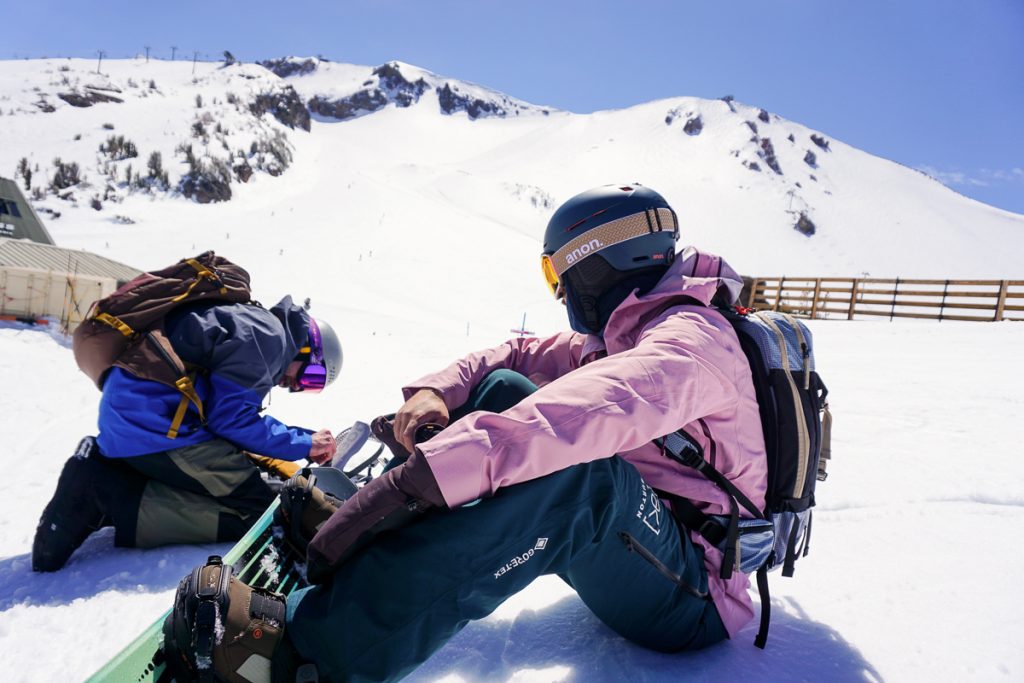
Good waterproofing keeps you dry when strapping in or tweaking your bindings. Photo: Will Sileo//The Inertia
Best Snowboard Pants Comparison Table
| Item | Price | Pant or Bib? | Waterproofing | Features |
| Burton [ak] Cyclic | $490 | Bib | 2L GORE-TEX | Big pockets |
| Quiksilver Mission | $270 | Pant | GORE-TEX | Inward facing vents |
| Burton [ak] Freebird Bibs | $699 | Bib | 3L GORE-TEX C-Knit | Breathable, mobile, great pockets |
| Patagonia Insulated Storm Shift | $449 | Pant | 2L PFC-Free GORE-TEX | Lined pockets |
| Jones Shralpinist Stretch Bibs | $475 | Bib | 3L 30K/30K fabric with 4-way stretch | Excellent mobility |
| Arc’teryx Sabre Bib | $700 | Bib | 3L GORE-TEX | Rubberized zippers |
| Burton [ak] Swash | $460 | Pant | 2L GORE-TEX | Durable, tons of pockets |
| REI Co-op First Chair GTX Bibs | $270 | Bib | 2L GORE-TEX | Inexpensive for quality |
| Mountain Hardwear Cloud Bank | $375 | Pant | 2L GORE-TEX | 60g Synthetic insulation |
| Mountain Hardwear Boundary Ridge | $475 | Bib | 3L GORE-TEX | Tons of pockets |
| Dakine Sender Stretch | $450 | Pant | 3L PFC-Free DWR | Stretchy |
| TREW Gear Tatoosh | $349 | Bib | 20K Nylon | 60g High Loft insulation |
| Patagonia Snowdrifter | $399 | Bib | 3L Recycled Polyester | Eco-friendly materials |
| Volcom Guide Pants | $640 | Pant | 3L GORE-TEX | Reinforced Butt Patch |
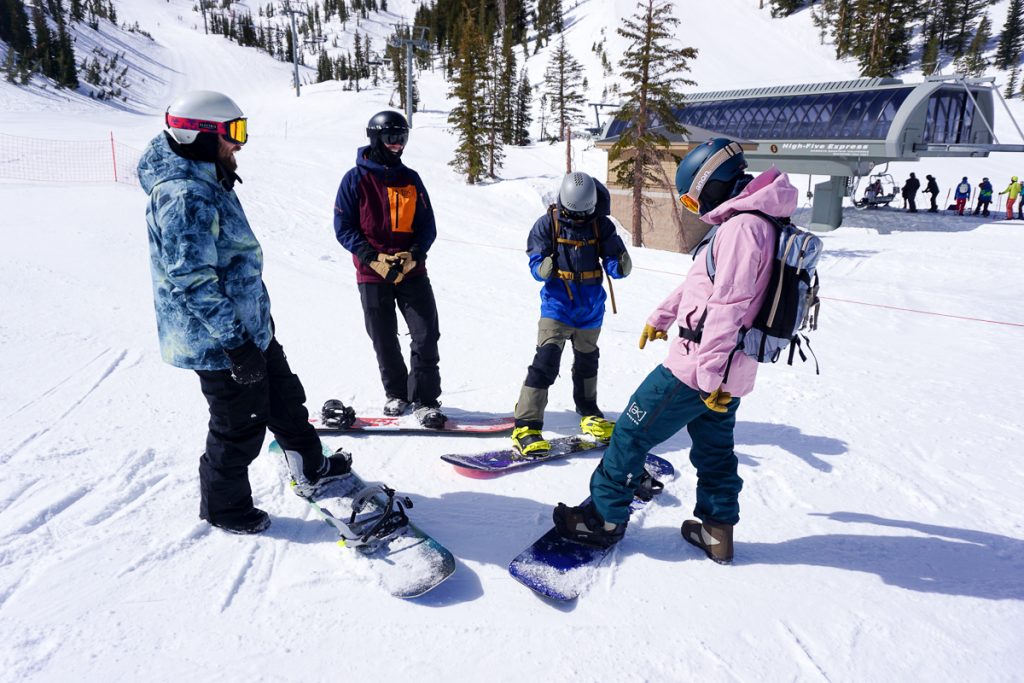
Comparing the latest and greatest snowboard pants. Photo: Will Sileo//The Inertia
How We Tested Snowboard Pants
We tapped into the wealth of knowledge that The Inertia team possesses and truly sought out advice and opinion from everyone. Editors Nathan Lemin and Will Sileo (who heads up ski gear and also snowboards) led the way, and writers Dylan Heyden and Steve Andrews contributed input and testing. We’ve been testing snowboard pants for over three years now, and we really believe our insights and guidance are among the best.
Nathan Lemin has been snowboarding since he was 11, originally in the Midwest and now out West. He tested snowboard pants in a range of locations and conditions, from Tahoe to Mammoth to Northern Arizona and beyond. From big powder dumps to balmy spring slush days and everything in between, he rotated through the list of pants with other riders to ensure each pair was considered on its merits, its use cases, and, let’s be real, its steeze (style-with-ease).
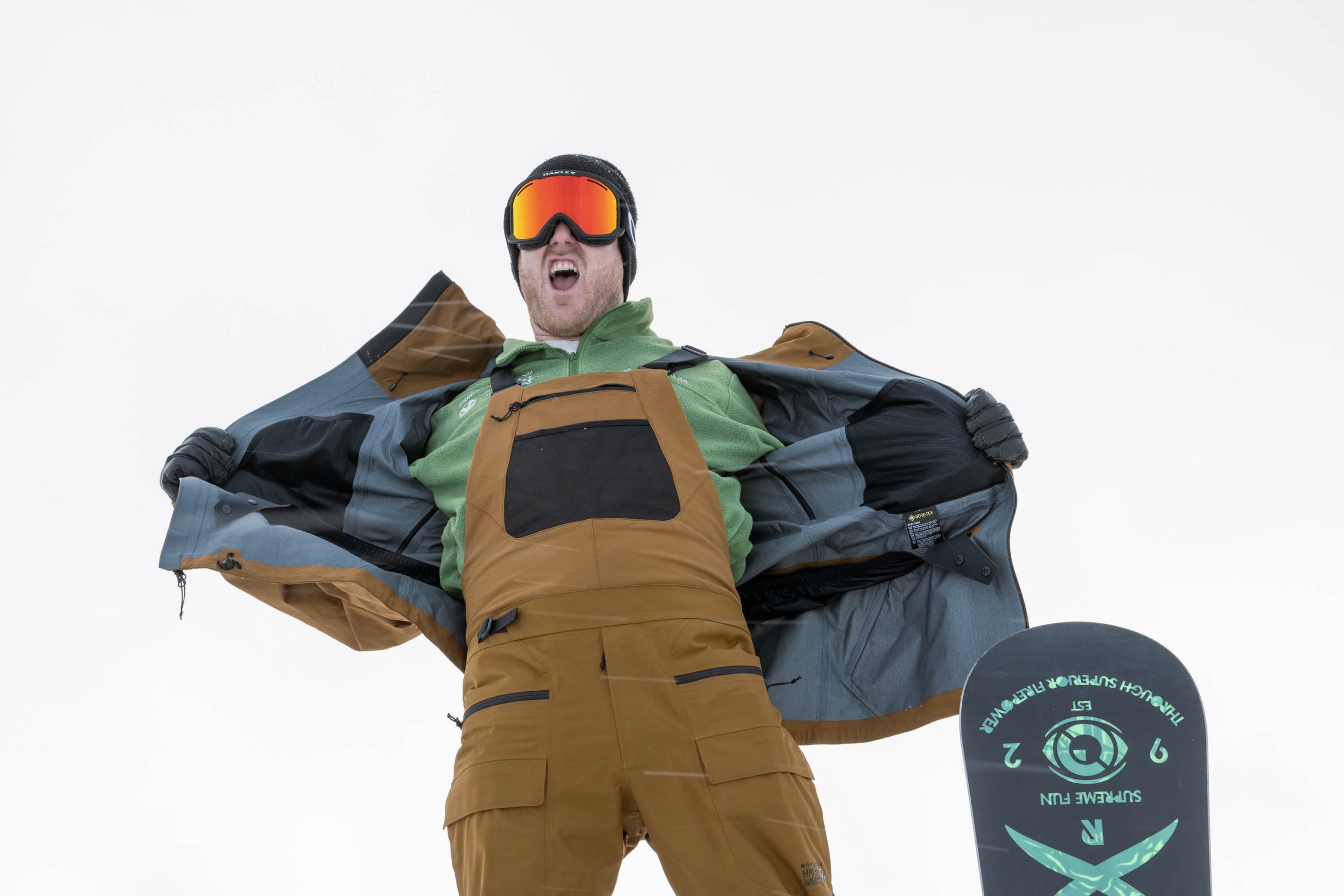
Snowboard pants or snowboard bibs—an age-old question. Photo: Reuben Krabbe//The Inertia
Steve Andrews grew up in the mountains. As a grom, he spent his time at Mount Baker, one of the most legendary snowboard destinations on Earth and home to the world record for snowfall in a single winter season. On top of the huge dumps, the coastal snow is well-known for being of the “wetter” variety, meaning if you don’t have high-quality protection, you’ll quickly get soaked. All this had him seeking out the best gear over the years, learning what’s most important from peers and mentors. Over the years Steve has also worked as a professional filmer and backcountry guide, so he knows what to look for in extras such as well-placed pockets that are easy to access and keep pricey accessories safe.
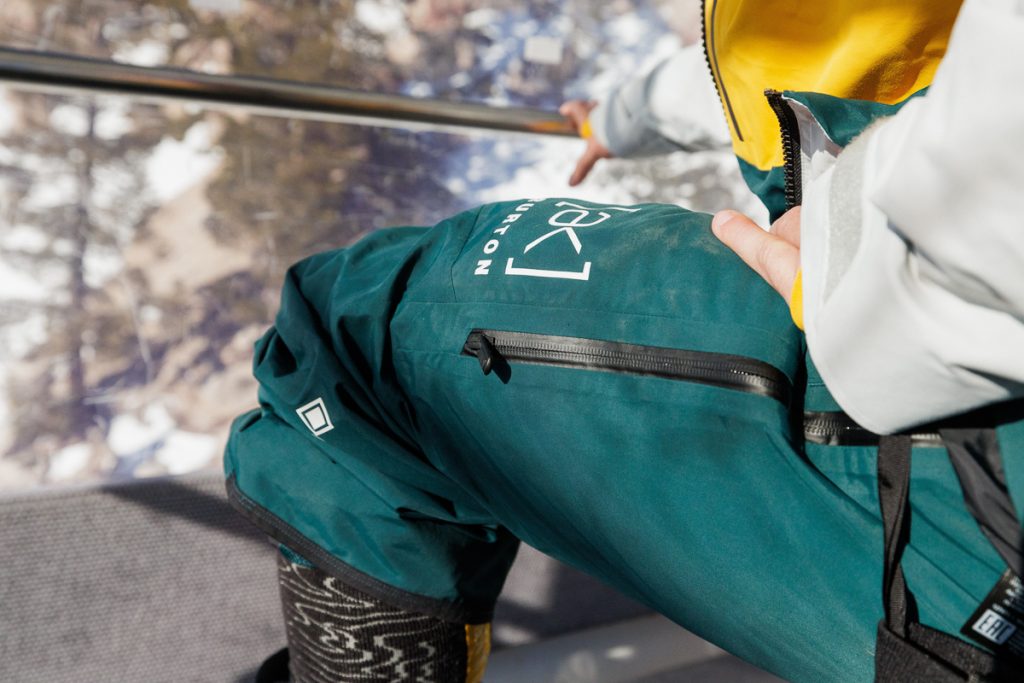
Pockets and ventilation make good snowboard pants great. Photo: Tim Manning//The Inertia
The team recruited a crew of die-hard shredders from Mt. Baker, Whistler, and beyond to assist in the testing process, ensuring that there wasn’t any personal bias toward one particular model simply based on fit. It’s also important to make sure to give each pair enough time in the mountains to check for wear and tear, and if the waterproofing holds up.
We started the testing process in January 2023 and have continued testing right on through March of 2025 with a selection of snowboard pants from the top brands, and spent the season rotating through the gear to compare. All in all, each pair of pants went on backcountry missions, big hikes, park days, and the all-important aprés sessions. Elements such as waterproofing and durability are important, but we also rated the pants on how well they could stash some extras and how easy it was to get to those extras when out in the elements.
Many of these brands also cater to skiers, which we found to be important to not fit into any marketing mold of who should wear the pants. There are traditional snowboard apparel brands out there, and also those that cater just to skiers. We threw all that nonsense out, knowing that a good pair of snowboard pants would be good for anyone. The main difference is that snowboarders are more often on their rear than skiers, which is just a reality of the sport. So if we found any discomfort on the ground while adjusting bindings, the pants wouldn’t make this list. Check out more ski-specific options at our Best Ski Bibs guide.
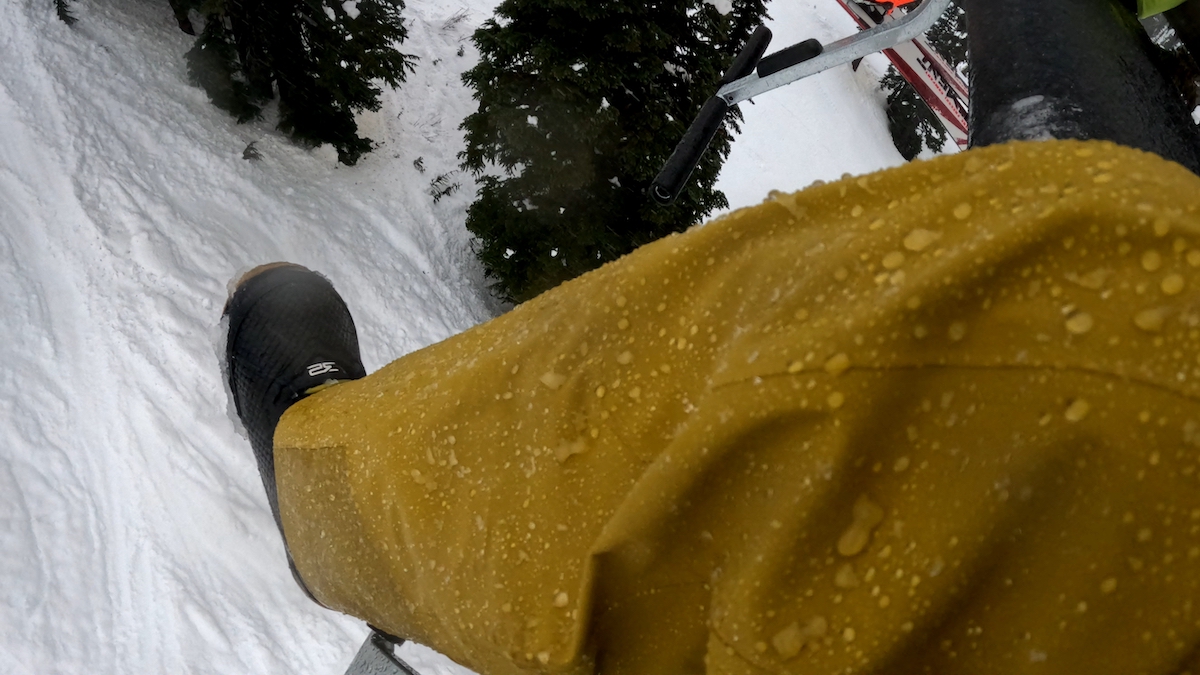
The DWR finish on the Arc’teryx Sabre Snowboard Pants doing its job. Photo: Steve Andrews//The Inertia
Snowboard Pants Buyers Guide
What are the important factors when looking for a good pair of pants? Aside from being able to stomp sick tricks, they need to survive the inevitable bails, as well. They also need to withstand the elements and consistently keep you warm and dry.
Waterproofing
Here on the “wet coast,” the constant deluge of rain and almost snow this season has produced some seriously soggy days. Most of us have heard of Gore-Tex, and indeed, it remains an excellent hard shell fabric. Some of these options use GTX, and others use in-house/proprietary waterproofing. There are different ratings for waterproofing: For example, 15k waterproofing means it will take 15,000mm of water stacked in a one-inch column to begin leaking. That’s enough to sustain a decent bit of rain, but for an absolute deluge, you’ll want to go with a shell that boasts something more like 20k waterproofing, such as in a 2L or 3L GTX fabric. Other brands like Pertex have made huge strides in the waterproof game, too.

Good ventilation is a necessity. The Storm Shift Pants from Patagonia take things up a level with mesh-protected vents to keep the snow out. Photo: Reuben Krabbe//The Inertia
Breathability
If snowboard pants don’t breathe, you’ll sweat, and when you stop moving, that sweat will get cold, causing temperature swings that fluctuate worse than a Sierra snowpack. Being able to regulate the heat will keep your core temperature on an even keel. This is important both in the resort and backcountry for different reasons. At the resort, you’ll need to keep warm on the chairlift without overheating, and in the backcountry, you’ll want to keep fresh air coming through as you hike, skin up, or shovel out that perfect booter. The Jones Shralpinist Stretch Bibs were the most breathable and comfortable kit we tested.
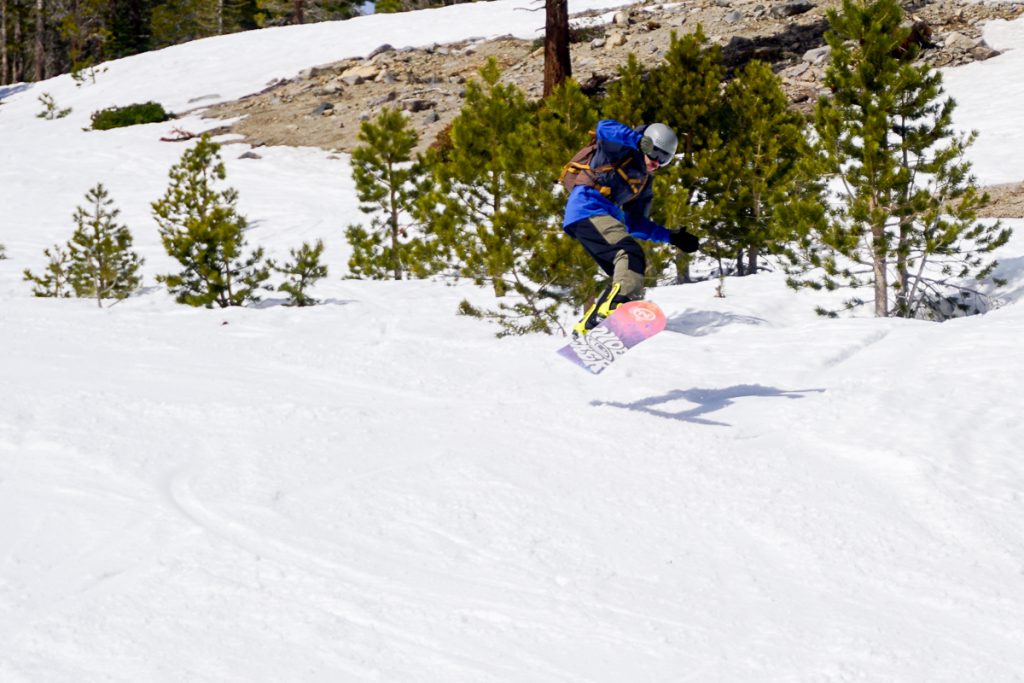
From airs to carves—comfort is a must in snowboard pants. Photo: Will Sileo//The Inertia
Comfort
Feeling good in your gear is a must. Without it, your mind will be distracted by annoying little things that shouldn’t be consuming brain space. Not to mention if movement is restricted, you can’t perform your best. Comfortable snowboard pants are essential to riding well — the last thing you want is to bail because the pants are too clunky to maneuver around in the air or through the trees. Few if any bibs were more comfy than the Burton [ak] Cyclic and Burton [ak] Freebird Bibs.
Pockets
A good pocket is like a reliable assistant. But bigger is not always better. It takes a careful balance to be large enough to hold things yet sleek enough not to become a burden with too much stuff to carry. Pockets also need to open and close with ease, especially in a hurry. Some impressive pockets were found on the Burton [ak] Swash.
Warranty/Repair
Wear and tear are inevitable if you’re shredding the gnar. Luckily, most brands are hip to the idea of the gear lasting as long as possible. Some offer repair services and a lifetime warranty. Others offer a limited warranty for a set period of time. If you are someone who buys gear for longevity (really, shouldn’t we all?), then it might be worth knowing who offers what.
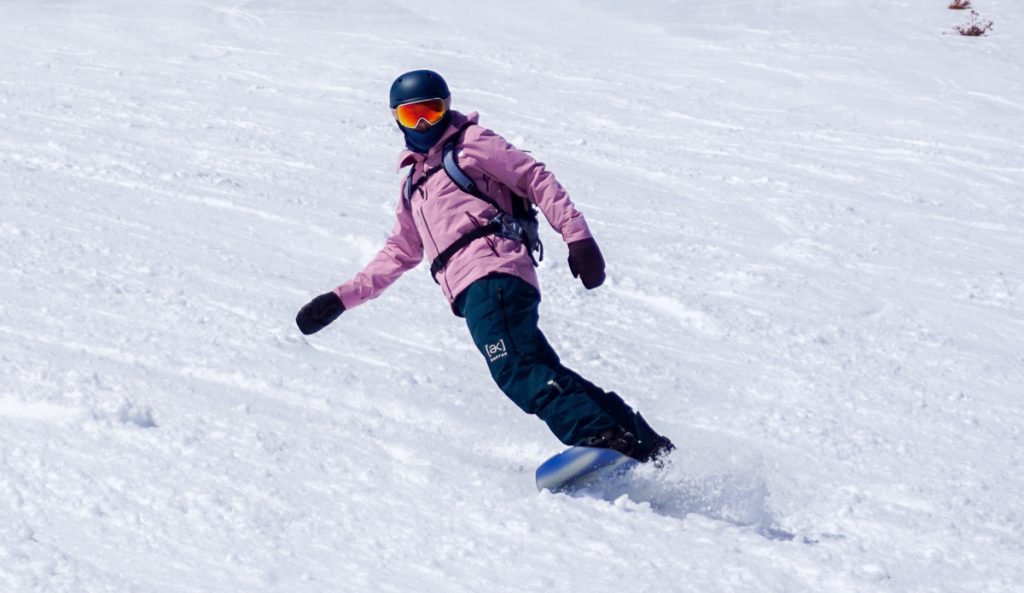
Good snowboard pants have to hold up to ice, slush, powder, and everything in between. Photo: Will Sileo//The Inertia
DWR vs Waterproof Membrane? Making Sense of the Jargon
There are a couple of major elements that go into what makes a good snowboard pant for playing in the snow, namely waterproofing and breathability. As you might expect, the two tend to cut against each other. Perfect waterproofing = zero breathability, and vice versa. That’s where all the fun tech comes into play. 2L and 3L, in outerwear-speak, point to the number of layers of fabric sandwiched together.
2-Layer Snowboard Pants
All winter outerwear has an outer layer, as well as a waterproof membrane beneath it. But that membrane needs to be separated from your skin, so 2L snowboard pants (at least those that don’t have an insulating layer or cozy liner) need some sort of hanging liner to keep your skin away from the waterproof membrane. That adds a bit of bulk and often reduces breathability (depending on what fabric the hanging liner is made out of). The Burton [ak] Cyclic performed best in the test while still utilizing a 2L fabric.
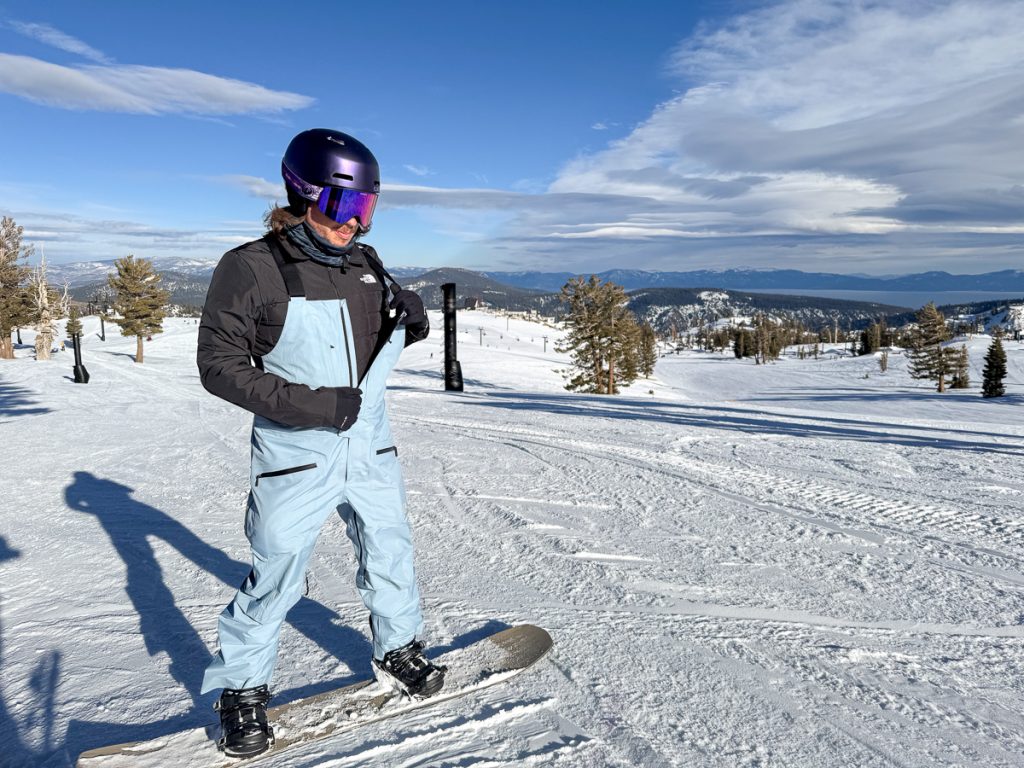
3L fabric is typically more mobile and breathable—great for backcountry use. Photo: Will Sileo//The Inertia
3-Layer Snowboard Pants
In a 3L snowboard pant, that third layer is fused to the other two, making for a more shell-like feel, cutting down on bulk, and improving breathability. However, with different types of interior linings, insulation, etc., it’s not so black and white as “3L is always better.” For those of us who spend 90-100 percent of our time on groomers, a 3L construction will be a bit overkill and not worth the uptick in price. Our favorite 3L pants were the Burton [ak] Freebird Bibs.
DWR
DWR (Durable Water Repellent) ignores what’s going on between the layers of fabric and focuses on the outer surface. A DWR finish helps water bead up and roll off instead of soaking into the outer layer of the fabric. That moisture will be stopped by the waterproof membrane beneath the exterior layer, but it will still add weight and chill. That’s why a DWR is important — and equally as important is maintaining that DWR over time. If you notice your snowboard pants aren’t repelling water like they used to, get your hands on a water-repellent treatment like this one from Nikwax to revive the water-impermeability of the shell.
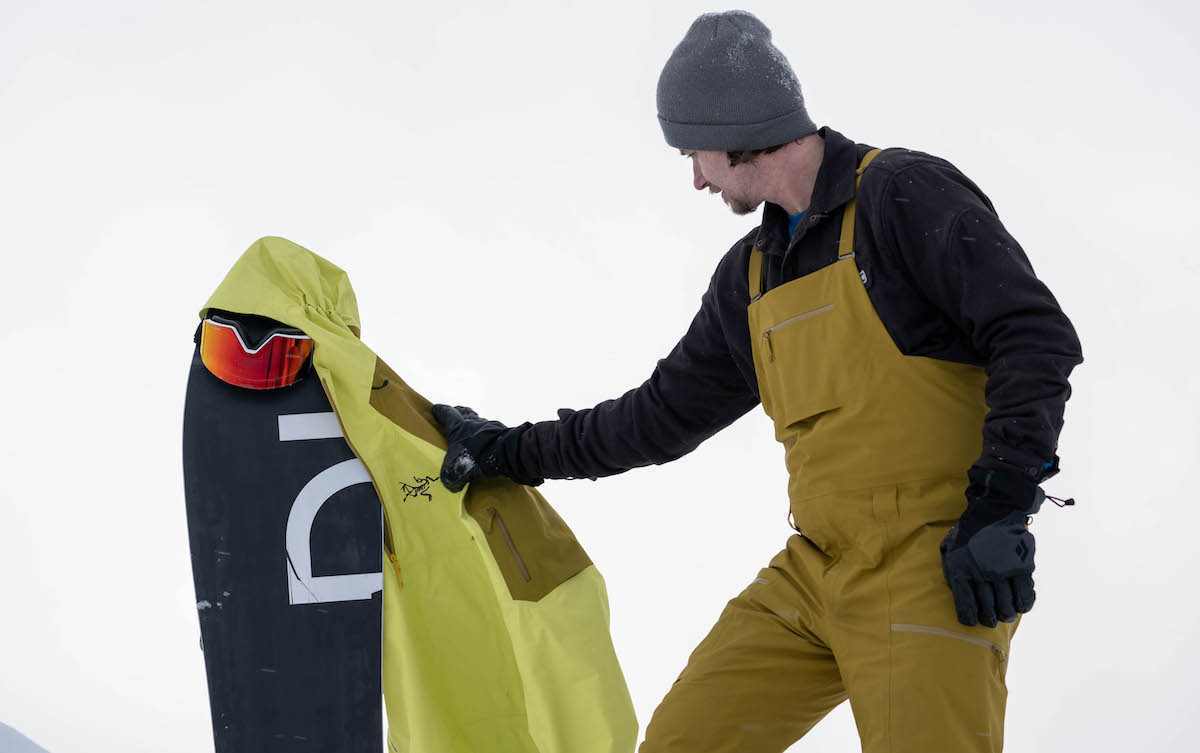
The Arc’teryx Sabre Bib is a great, full-coverage snowboard pant with a tough fabric. Photo: Reuben Krabbe//The Inertia
Caring for Your Snowboard Pants
These pants are all designed to be long-lasting, but you can do your part to ensure they last as long as possible.
Storage
Make sure you store your pants with care. I know from painful (and smelly) experiences that just tossing it in the backseat will add further wear and tear and invite some microscopic friends. The more the fabric rubs against surfaces, the more the waterproof coating will go away, so be sure to hang it up, if possible, in a warm and dry place. Stashing it outside in the elements will lower its performance.
Repairs
As mentioned before, most companies offer some sort of repair policy. The key is to take advantage of it! Don’t let something small turn into something big out of laziness. These days, some repair marks can be seen as a badge of honor. It means you’re really using the gear to its fullest. Plus, it’s so much cheaper than buying something new, so there really isn’t much reason to let things go unrepaired. Pay close attention to the seams at the zippers. Those are often the first places to go.
Washing
Be sure to check the tag for detailed instructions, but a good idea is only to wash cold and to use gear/tech wash, not traditional detergent. If you use the dryer, use a low-temperature setting, and if you hang dry, you may need to use an iron (not too hot!) to reactivate the waterproof coating.

The fuller coverage of a bib is a great choice for snowboarding and keeping that fluffy powder out of your underlayers. Photo: Reuben Krabbe//The Inertia
Waterproofing
The DWR waterproof coating can rub off over time, so it’s a good idea to reapply a waterproof treatment like Nikwax every so often. Be sure to test a small area before applying to make sure it gets the desired result. Don’t forget to read the instructions, as different products work better for various fabrics. Depending on where you ride and how often you ride will determine how often you want to do this treatment. Once every 100 or so days of riding should be good.
Editor’s Note: Looking for women’s options? Check out our Best Women’s Snowboard Pants guide. For more gear reviews and features on The Inertia, click here.
Return To: Comparison Table | Top Picks




